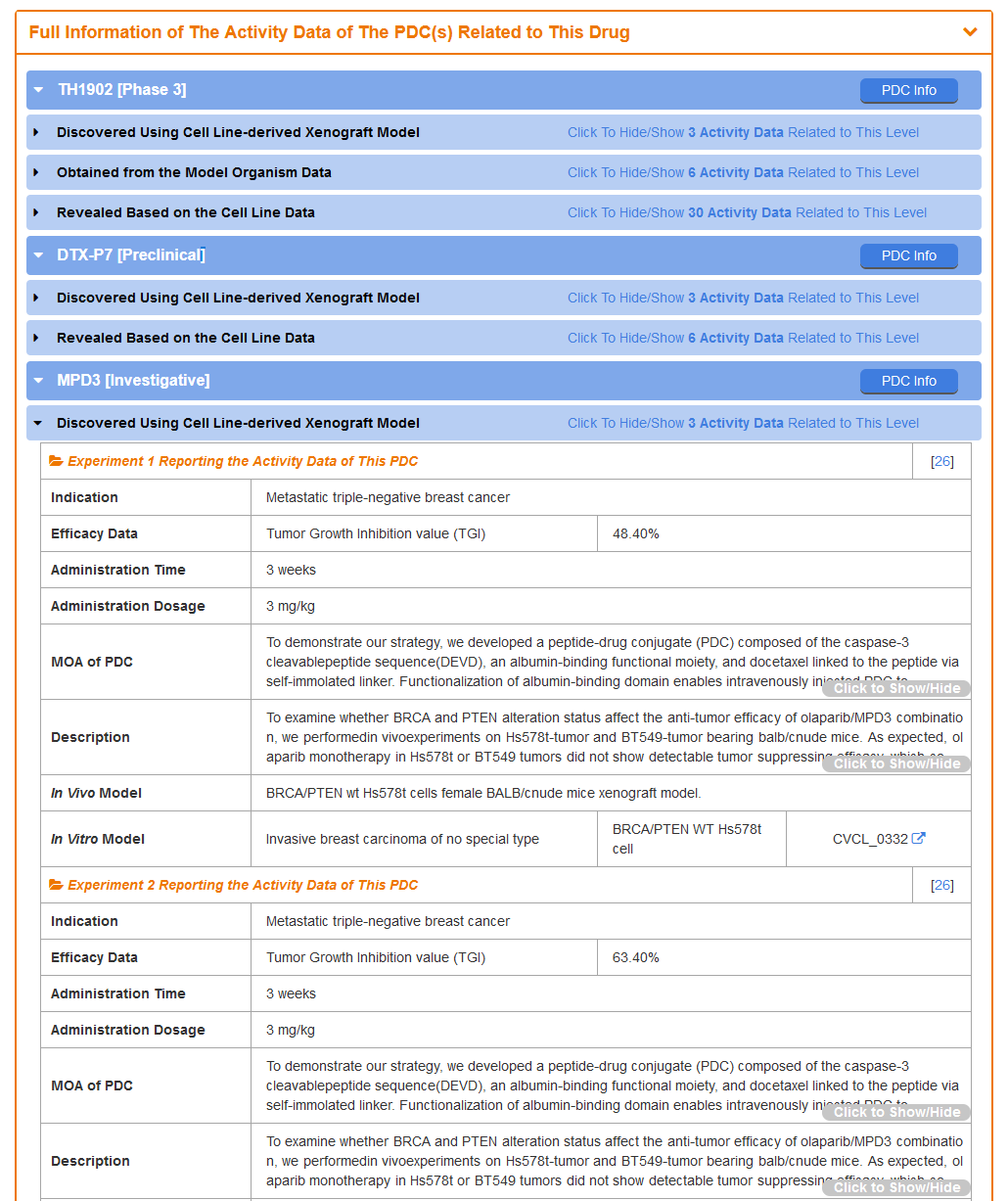In the field of “Search for PDC”, users can find PDC entries by searching PDC name, peptide name, linker name, payload name, receptor name, gene name, and so on among the entire textual component of PDCdb. Query can be submitted by entering keywords into the main searching frame. The resulting webpage displays profiles of all the PDCs directly related to the search term, including PDC name, Drug status, Peptide name, Linker name, Payload name, Receptor name and their information links.
In order to facilitate a more customized input query, the wild characters of “*” and “?” are also supported.
(1) If search “Paclitaxel”, find a single API entry which is named “Paclitaxel”;
(2) If search: “Lu-PSMA”, finds a series entries with PDC names;
(3) If search: “ANG1005*”, find a single entry which is named “ANG1005”;
For example, if you want to know the detail information for ANG1005, you can search “ANG1005” in the “Search for PDC” field.
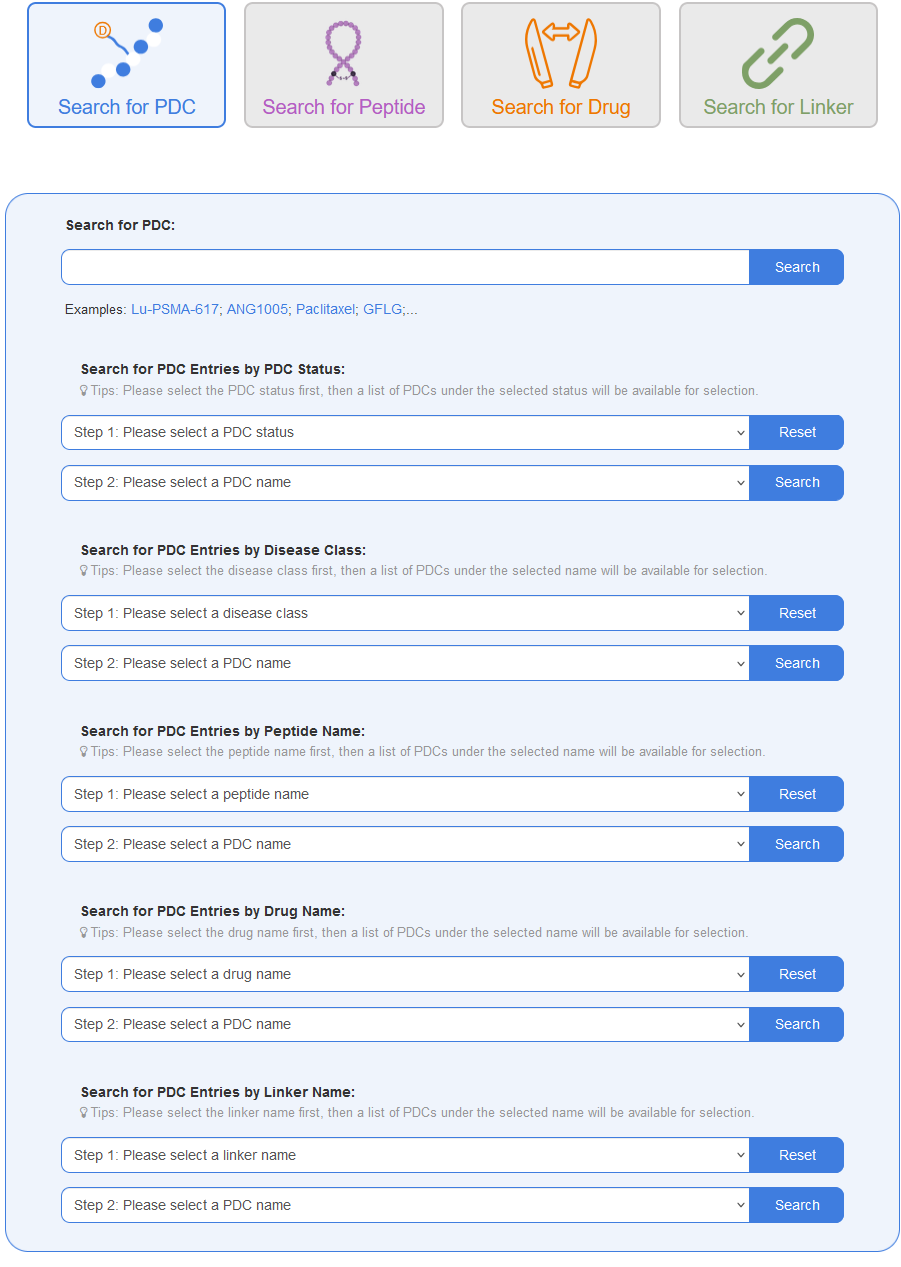
Search result of the “ANG1005” shows the information of PDC ID, PDC Name, PDC Status, Indication, Peptide Name, Drug Name, Linker Name and External buttons. The “PDC Info” button links to the detailed PDC information page of ANG1005. The “Peptide Info” button links to the detailed peptide information page of Angiopep-2. The “Drug Info” button links to the detailed peptide information page of “Paclitaxel”. The “Linker Info” button links to the detailed linker information page of "Succinic acid".
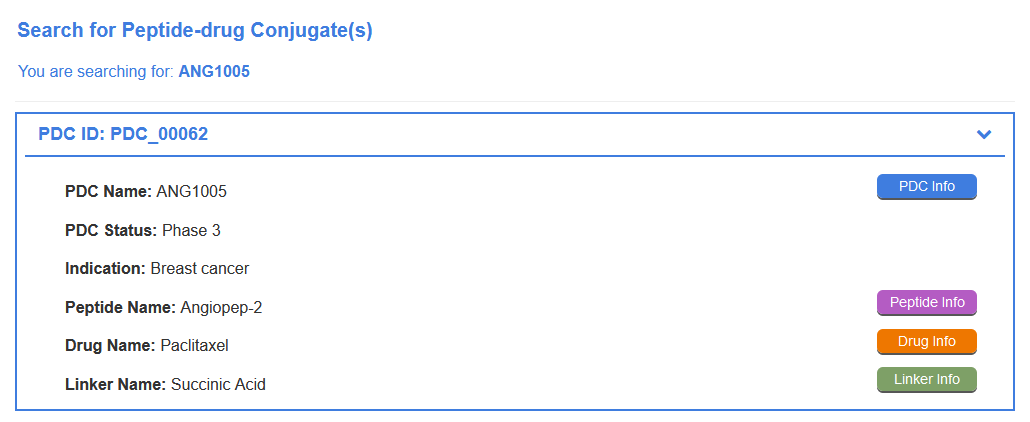
1.1. By clicking the “PDC Info” button, the detailed information page for particular PDC will be displayed
Take ANG1005 as an example, “General Information of This Peptide-Drug Conjugate (PDC)” section displays the general information of ANG1005 including its ID, Name, Status, Indication, Structure, Peptide Name, Receptor Name, Drug Name, Therapeutic Target, Linker Name, Drugbank ID, Pharm-Information and External Link(s). In addition, this section displays the general information of ANG1005 including its PDC Name, Peptide Name, Receptor Name, Drug Name, Linker Name, and Indication(s).
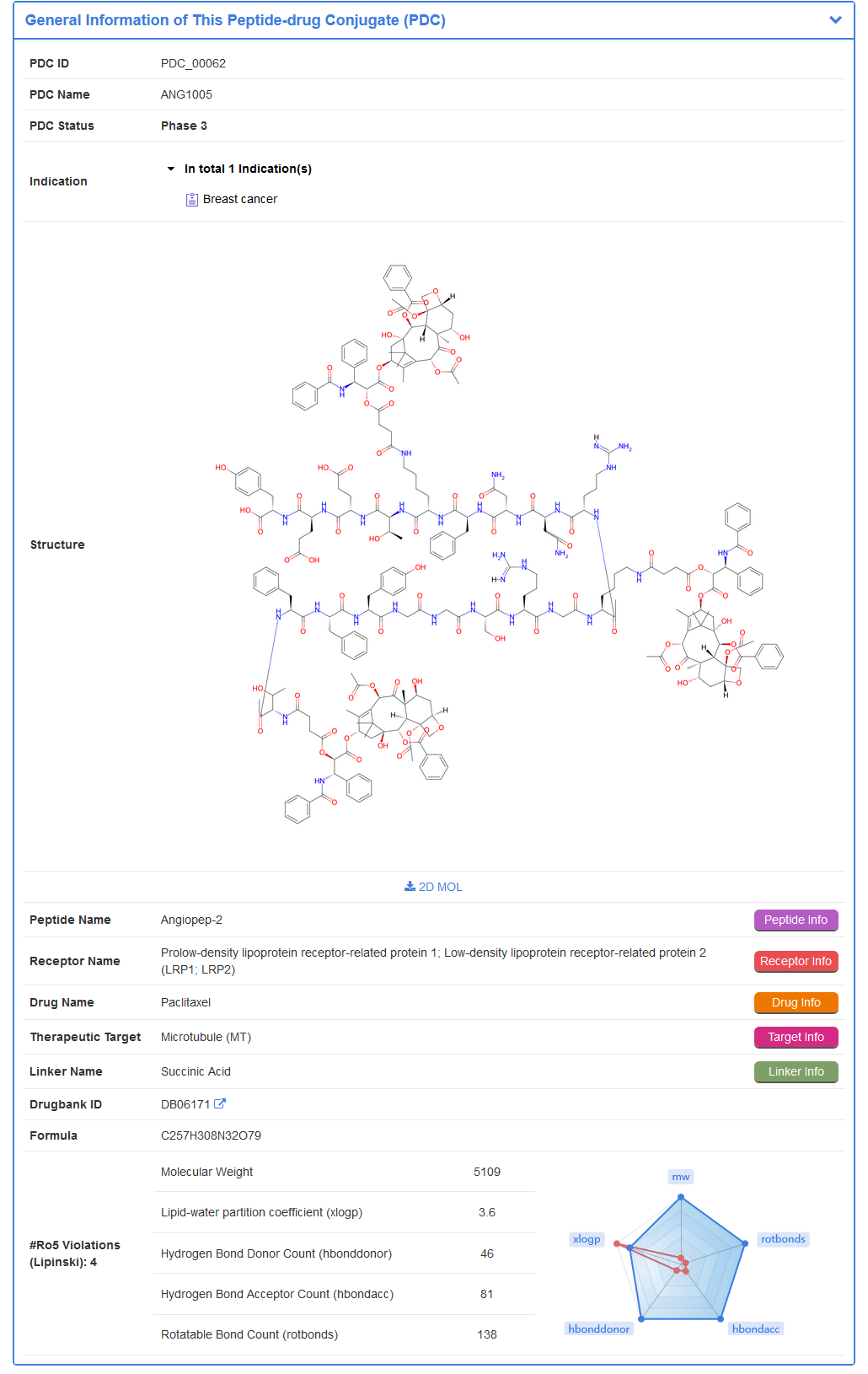
Some of the PDCs in the PDCdb have corresponding clinical study activity. The “Identified from the Human Clinical Data” section in the “Full List of The Activity Data of This Peptide-drug Conjugate” shows the Indication, Efficacy Data and Description.
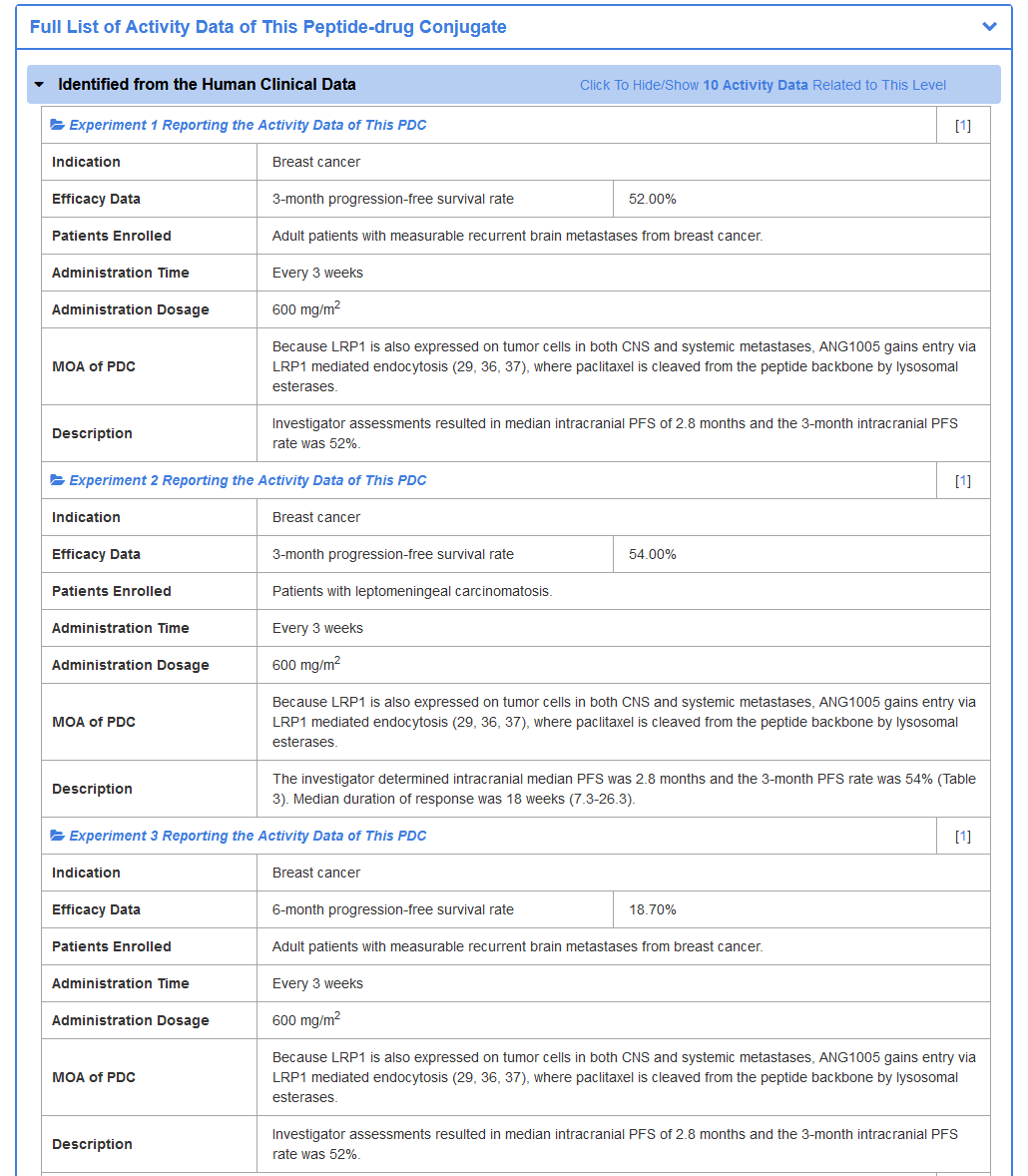
1.2. By clicking the Peptide Info” button, the detailed peptide information page will be displayed
Take Angiopep-2 as an example, “General Information of This Peptide” section displays the general information of peptide, including its Name, Sequence, Peptide Type, Receptor Name, PDC Transmembrane Types.

"Each Peptide-drug Conjugate Related to This Peptide" section displays the PDCs associated with this peptide, with each button provided jumping to the corresponding PDC page.
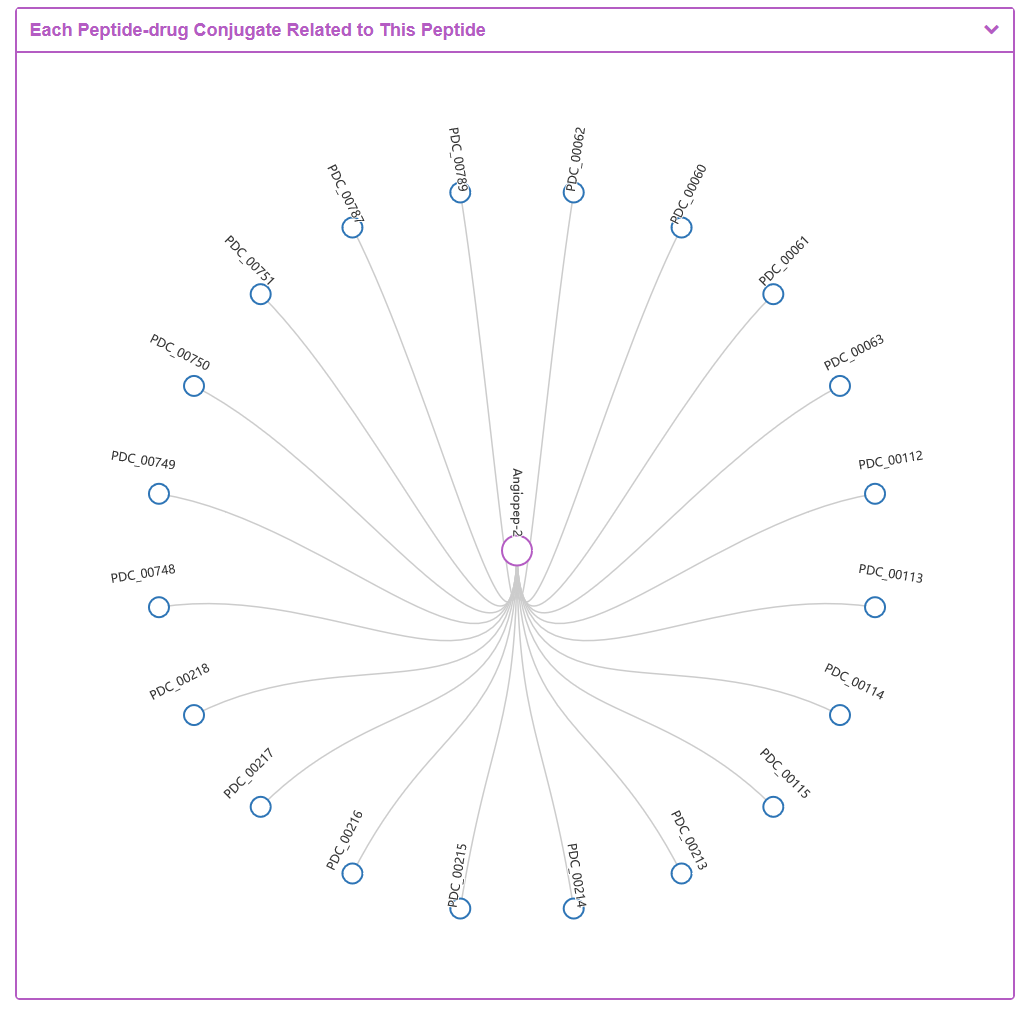
The "Full Information of The Activity Data of The PDC(s) Related to This Peptide" section systematically reveals the PDCs conjugated with this peptide. The list shows the different PDCs and the stage of research. User can get an overview of the different levels of activity data for each PDC, or easily jump to the corresponding PDC page by clicking on PDC Info.
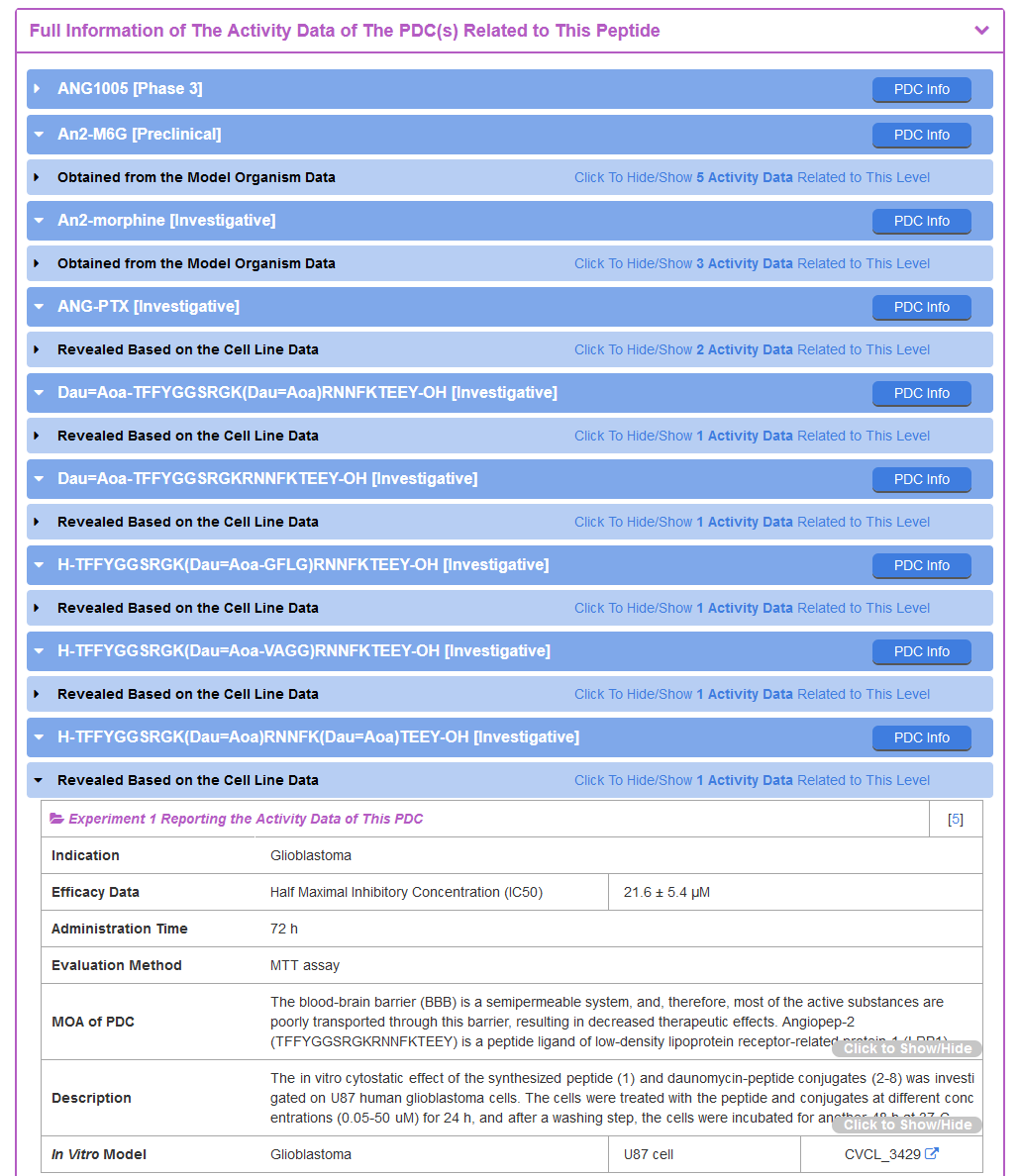
1.3. By clicking the “Drug Info” button, the detailed drug information page for will be displayed
Take Daunorubicin as an example, “General Information of This Drug” section displays the general information of drug, including its ID, Name, Synonyms, Target(s), Structure, Formula, Canonical smiles, PubChem CID, InChI, InChIKey, IUPAC Name, Pharmaceutical Properties and External Link(s). It is important to note that Pharmaceutical Properties is calculated by RDKit.
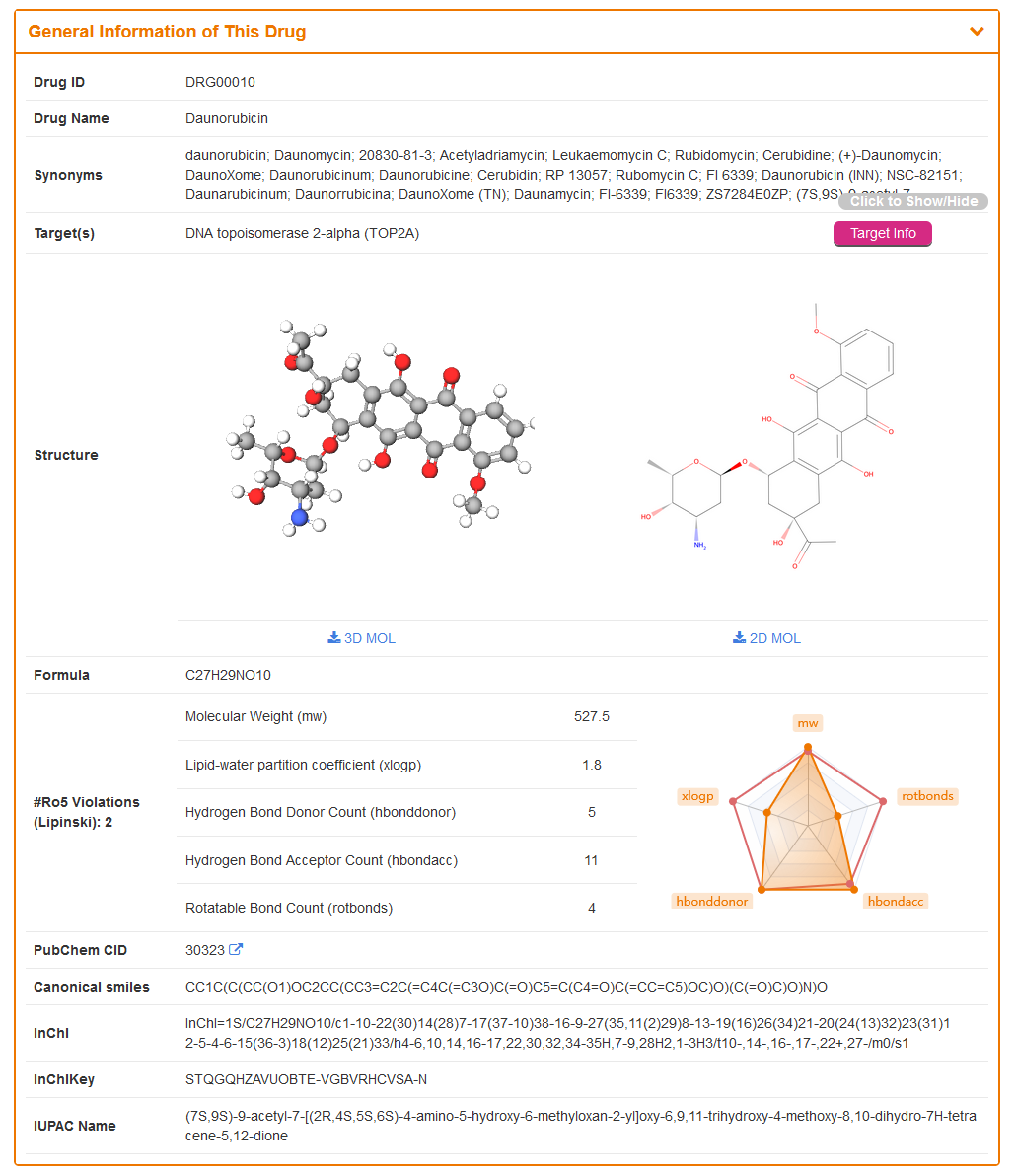
Some of the drugs in the PDCdb have corresponding single-use activities in vitro, and most are evaluated using IC50 index. The “The Activity Data of This Drug” section shows the Standard Type, Value, Units, Cell line, Disease and Cell line ID.
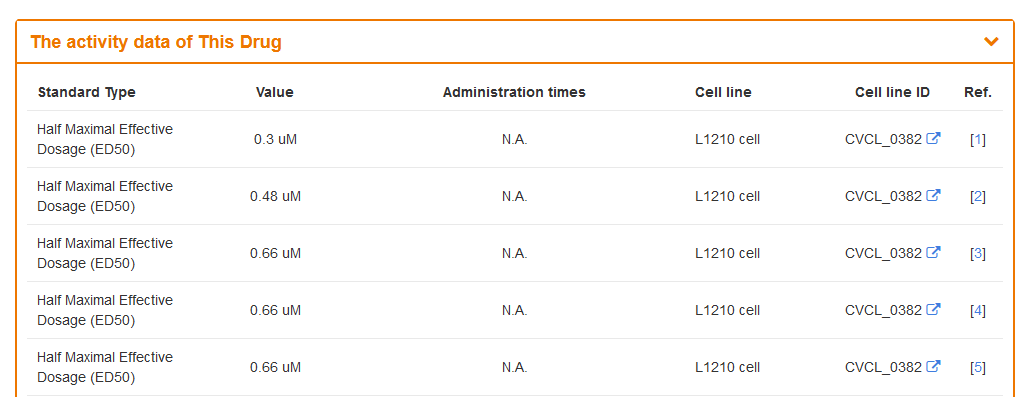
"Each Peptide-drug Conjugate Related to This Drug" section displays the PDCs associated with this drug, with each button provided jumping to the corresponding PDC page.
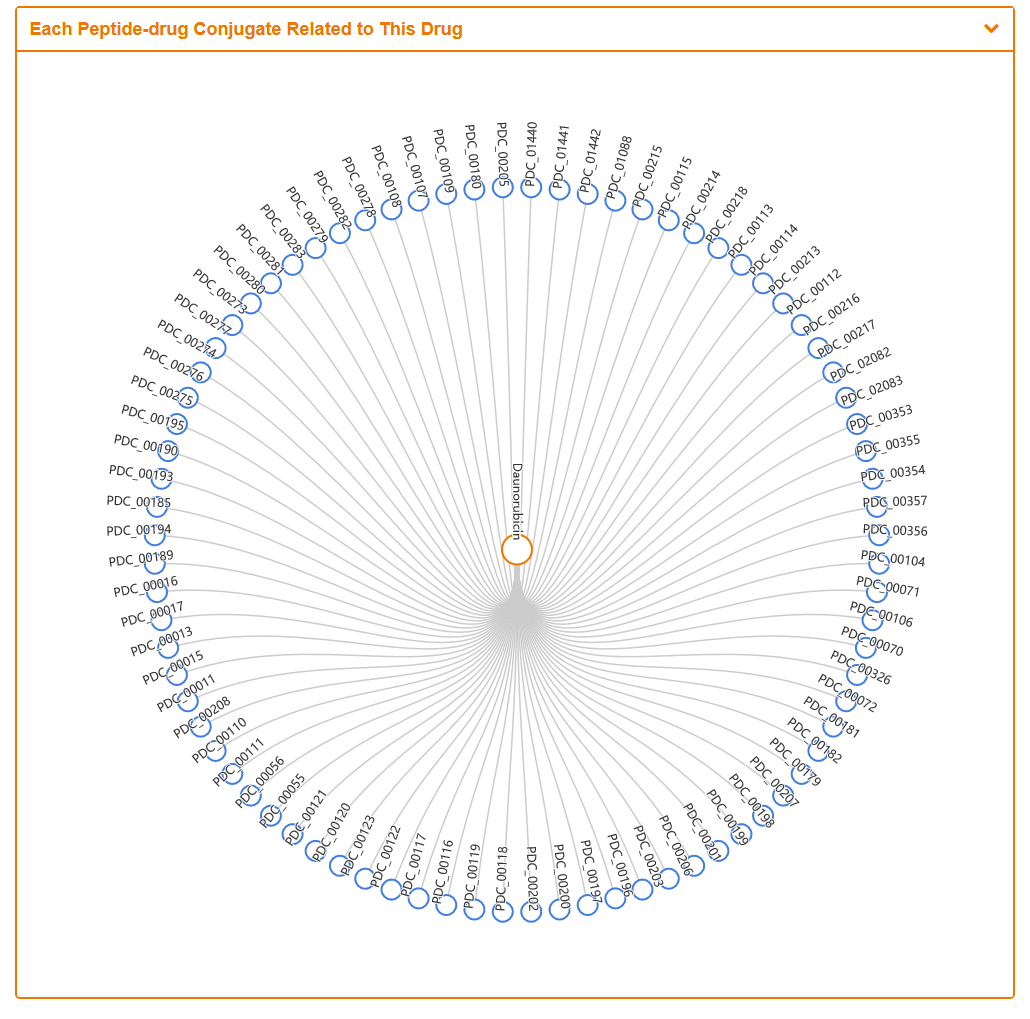
The "Full Information of The Activity Data of The PDC(s) Related to This Drug" section systematically reveals the PDCs conjugated with this drug. The list shows the different PDCs and the stage of research. User can get an overview of the different levels of activity data for each PDC, or easily jump to the corresponding PDC page by clicking on PDC Info.
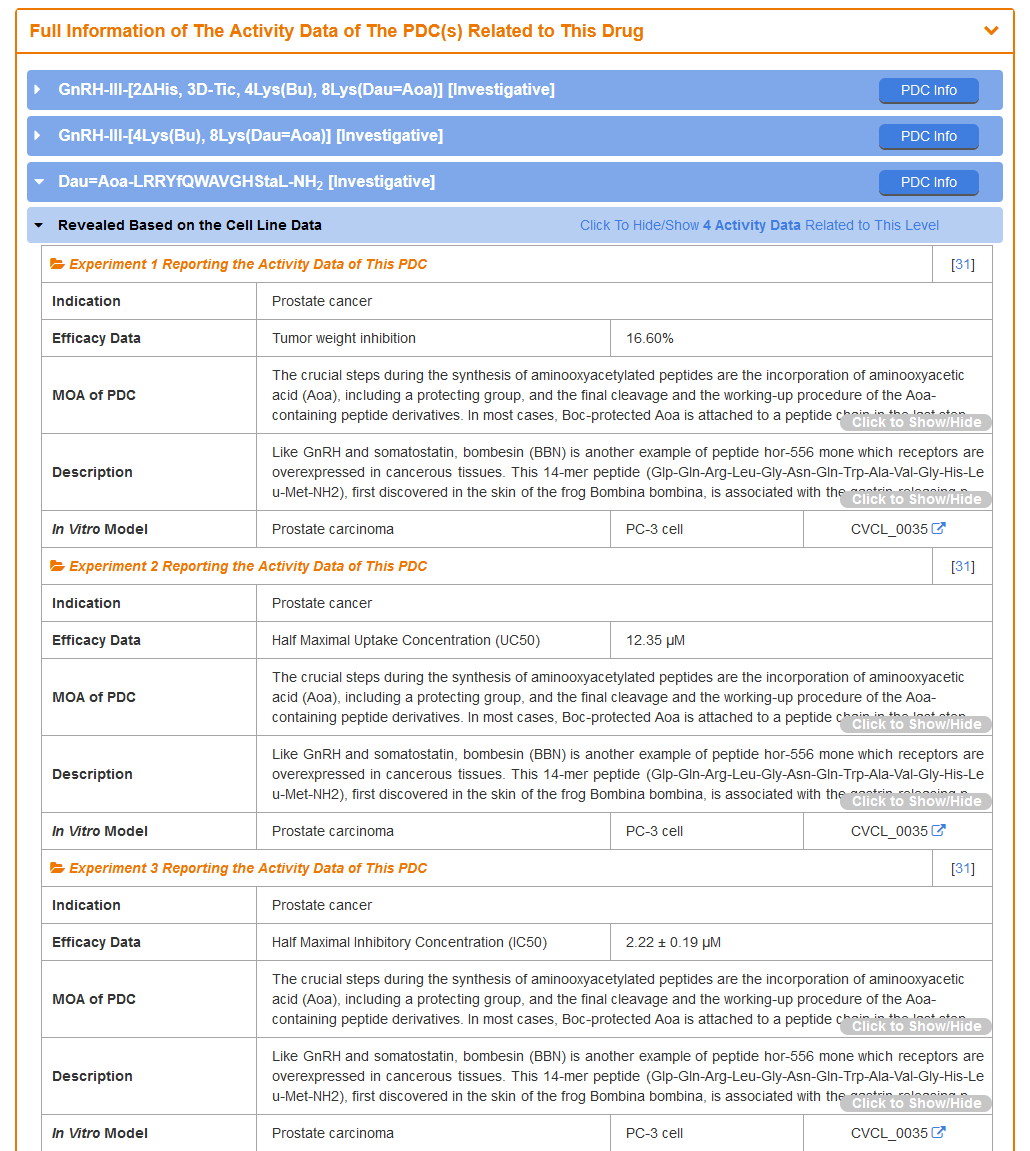
1.4. By clicking the “Linker Info” button, the detailed linker information page for will be displayed.
Take Succinic Acid as an example, “General Information of This Linker” section displays the general information of linker, including its ID, Name, Linker Type, Structure, Formula, Canonical smiles, PubChem CID, InChI, InChIKey, IUPAC Name, Pharmaceutical Properties and External Link(s). It is important to note that Pharmaceutical Properties is calculated by RDKit.
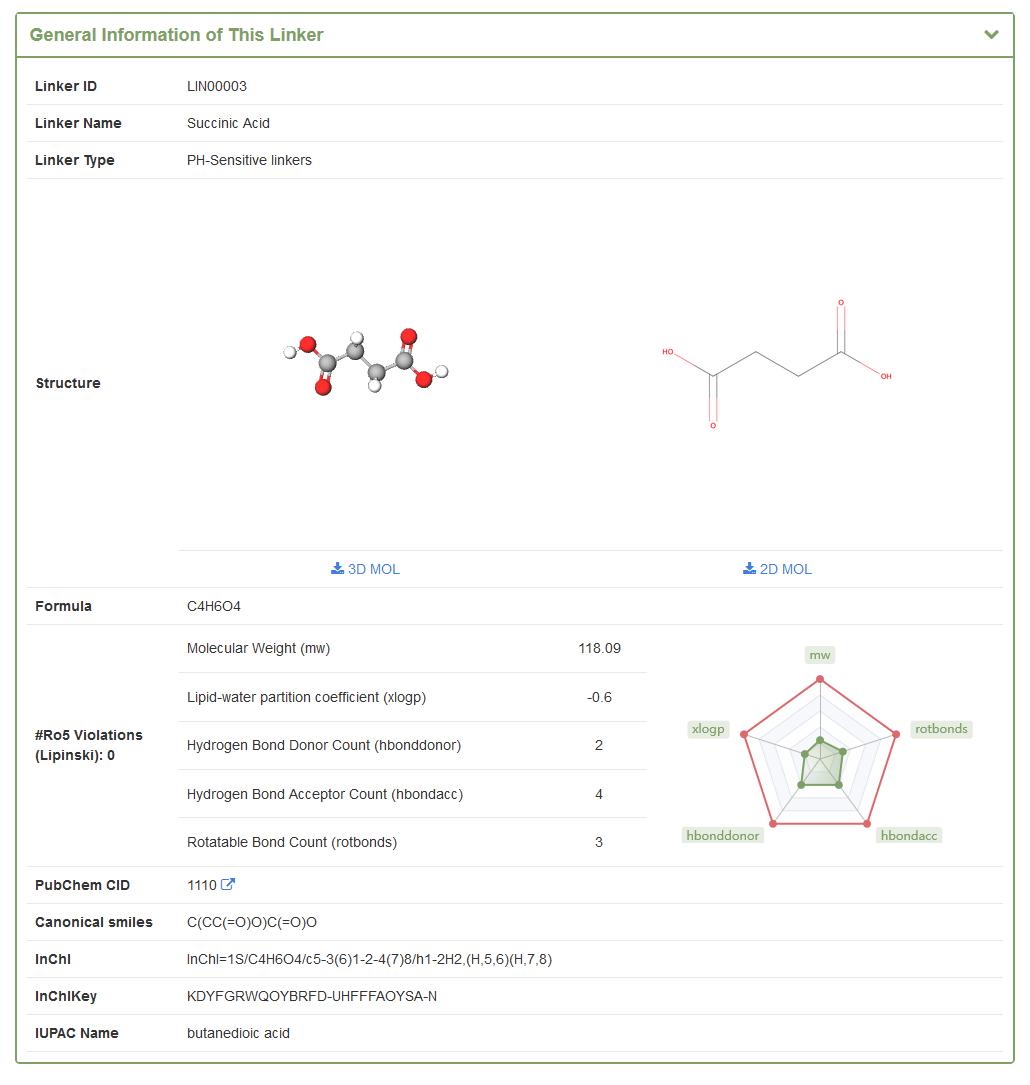
"Each Peptide-Drug Conjugate Related to This Linker" section displays the PDCs associated with this linker, with each button provided jumping to the corresponding PDC page.
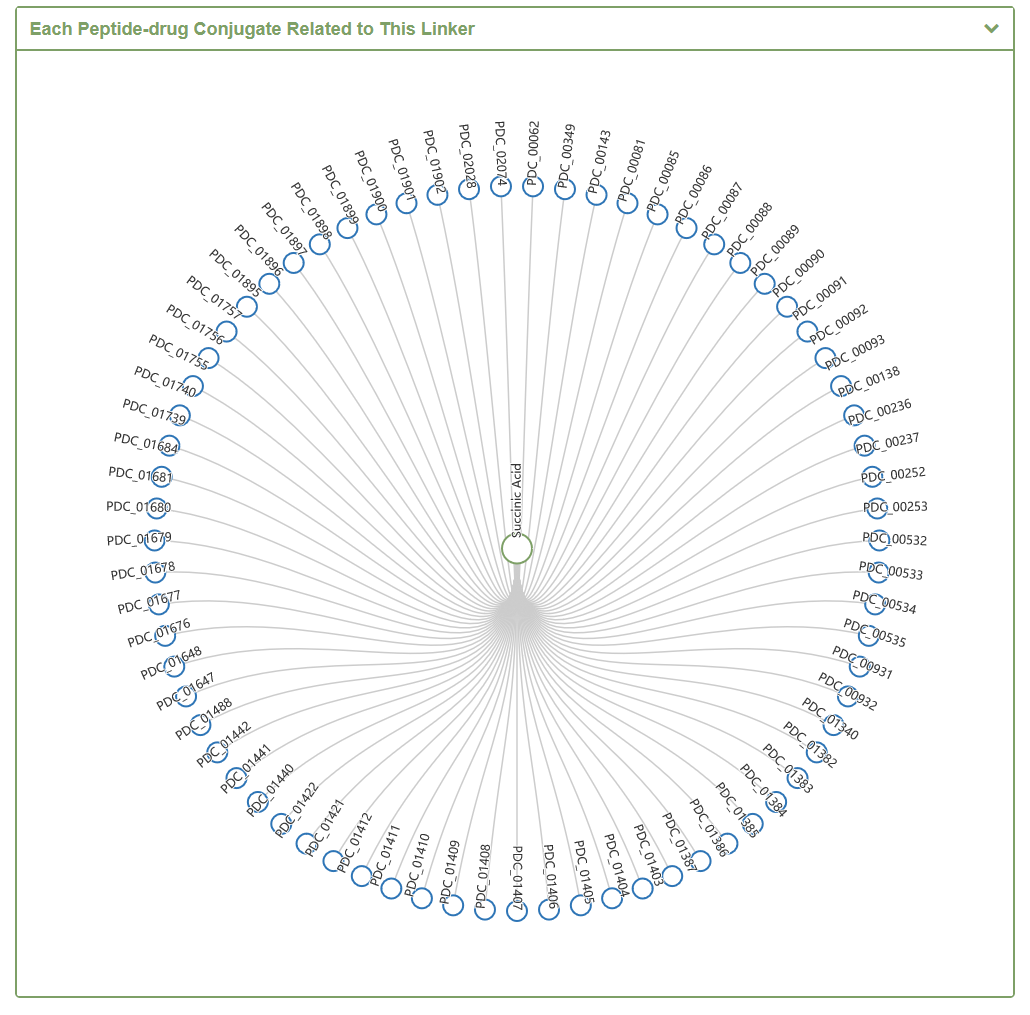
The "Full Information of The Activity Data of The PDC(s) Related to This Linker" section systematically reveals the PDCs conjugated with this linker. The list shows the different PDCs and the stage of research. User can get an overview of the different levels of activity data for each PDC, or easily jump to the corresponding PDC page by clicking on PDC Info.
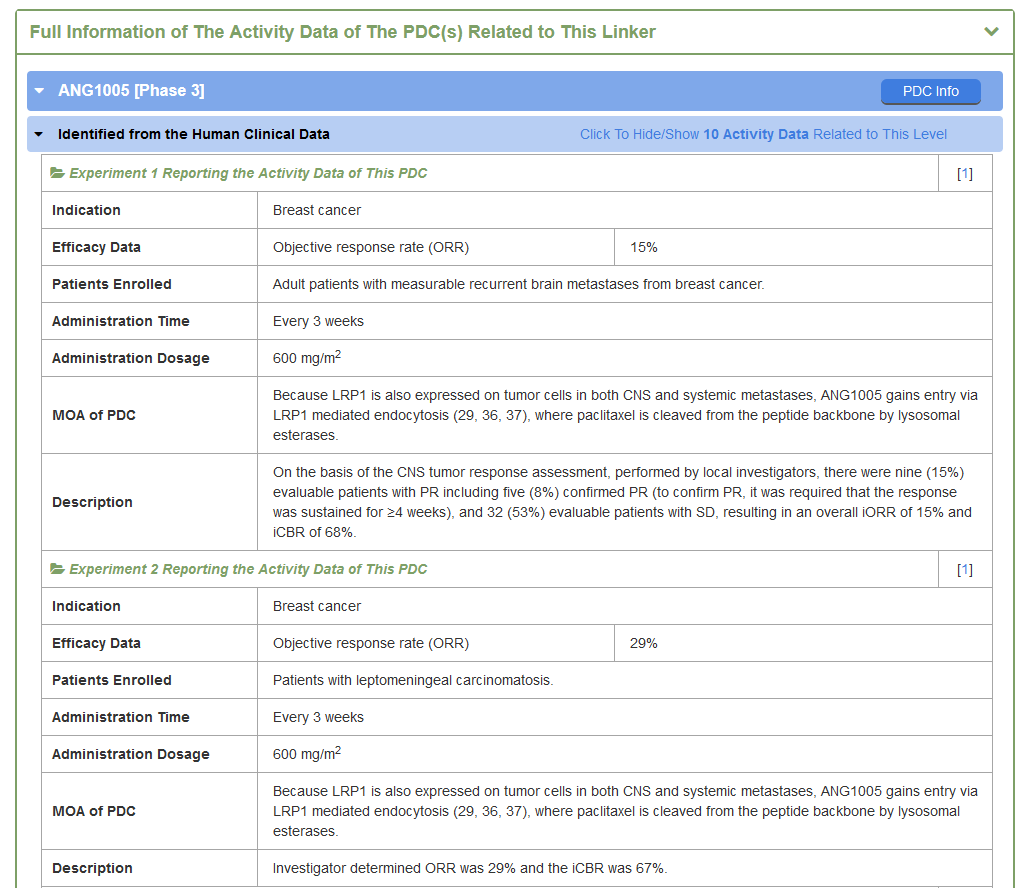
In the field of “Search for Peptide, users can find peptide entries by searching peptide name, target name, PDC name, linker name, payload name, and so on among the entire textual component of PDCdb. Query can be submitted by entering keywords into the main searching frame. The resulting webpage displays profiles of all the peptides directly related to the search term, including PDC name, Peptide name, Linker name, Payload name, Receptor Name,and their information links.
In order to facilitate a more customized input query, the wild characters of “*” and “?” are also supported.
(1) If search “3-Tyr-Octreotide”, find two API entries which is named “3-Tyr-Octreotide”;
(2) If search: Acetic*”, find a single entry which is named “Acetic acid”;
For example, if you want to know the detail information for Acetic acid, you can search “Acetic acid” in the “Search for Peptide” field.
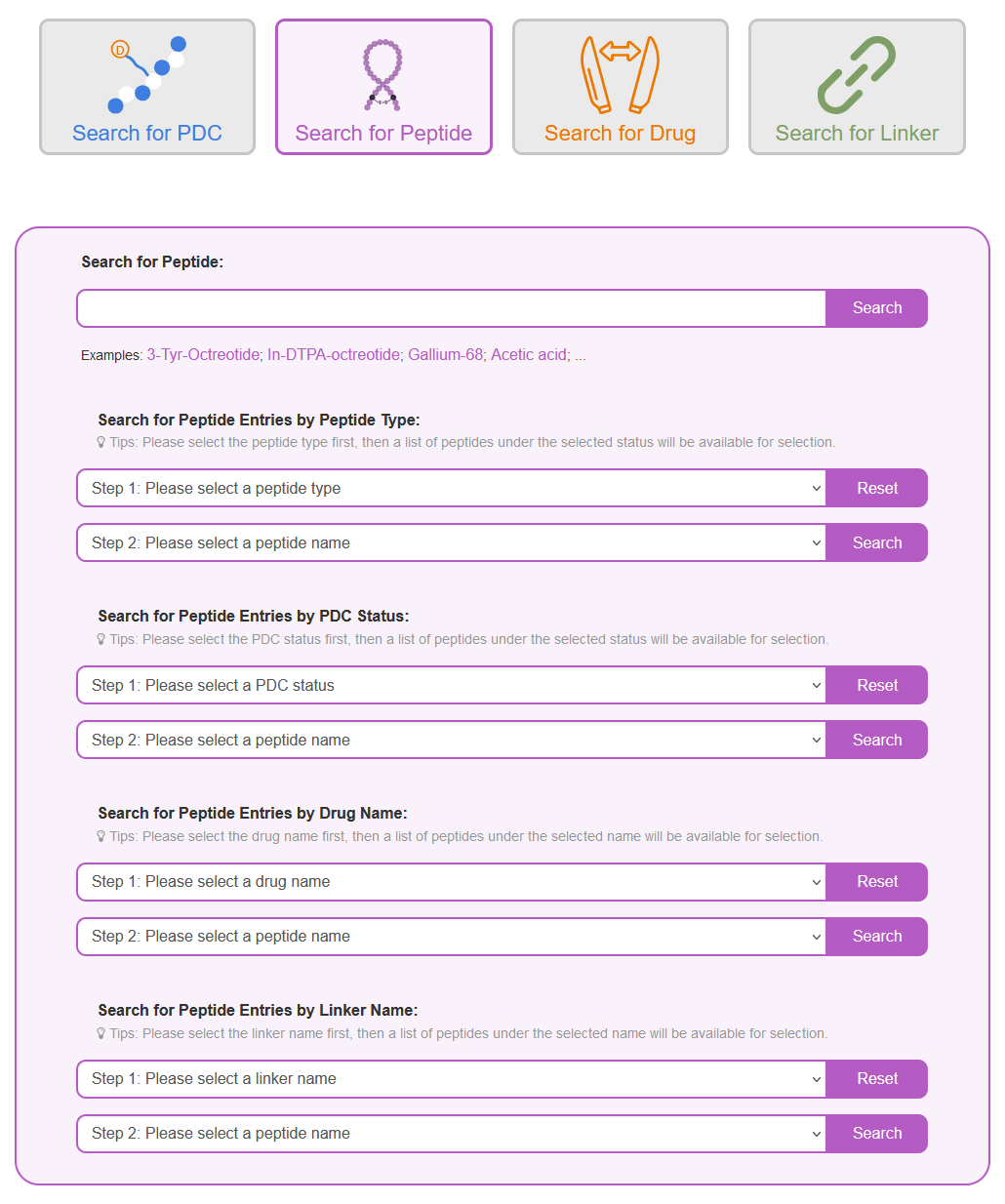
Search result of the 3-Tyr-Octreotide shows the information of Peptide ID, Peptide Name, Related PDC Name, Indication, Drug Name, Linker Name and External buttons. The “Peptide Info” button links to the detailed peptide information page of 3-Tyr-Octreotide. The “PDC Info” button links to the detailed PDC information page of 67Ga-MMC(TMZ)-TOC. The “Drug Info” button links to the detailed payload information page of Temozolomide. The “Linker Info” button links to the detailed linker information page of Amide bond.
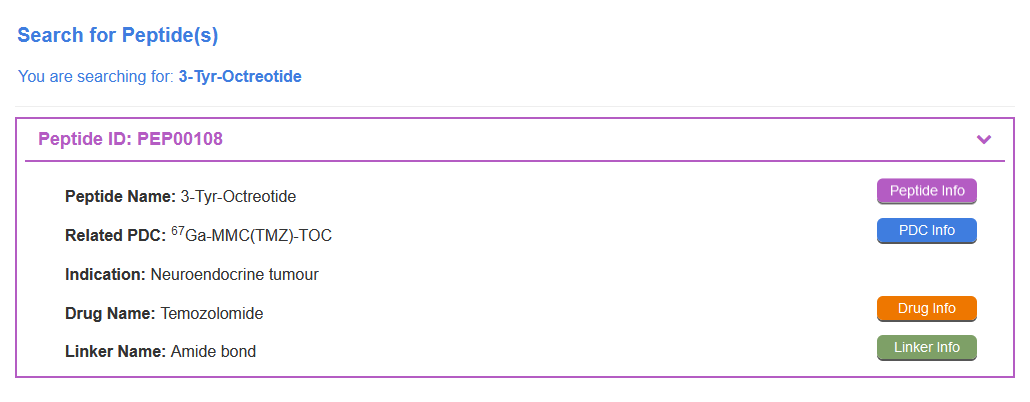
2.1. By clicking the “Peptide Info” button, the detailed peptide information page will be displayed
Take TH19P01 as an example, “General Information of This Peptide” section displays the general information of peptide, including its Name, Peptide Type, Peptide Half Life Period, Receptor Name, PDC Transmembrane Types, Distribution, Excretion and External Link(s).

By clicking the “Receptor Info” button, the detailed receptor information page will be displayed.
Take SSTR1 as an example, “General Information of This Receptor section displays the general information of receptor, including its ID, Name, Gene Name, Gene ID, Synonym, Sequence, Family, Function, Uniprot Entry, HGNC ID, KEGG ID and External Link(s).
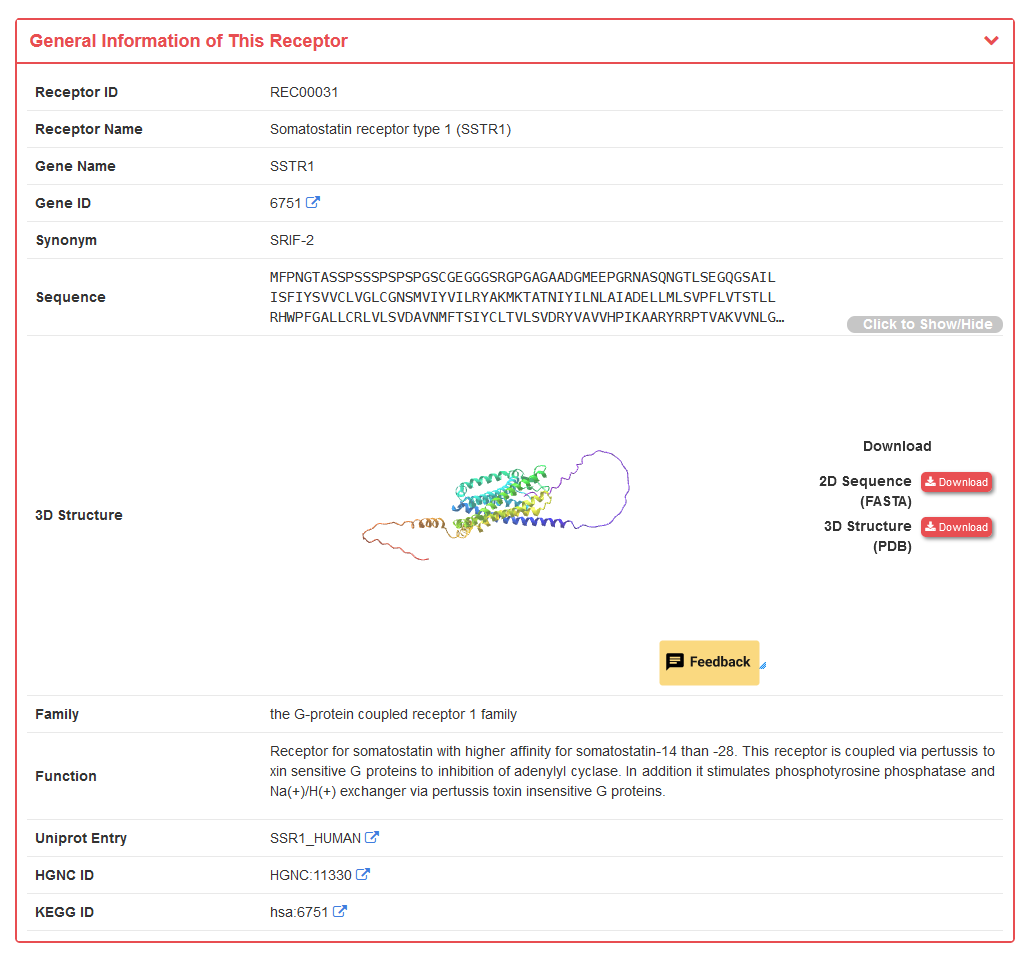
"Each Peptide-drug Conjuate AND It's Component Related to This Receptor" section systematically displays the peptides associated with the receptor and the PDCs and drug information corresponding to each peptide. .
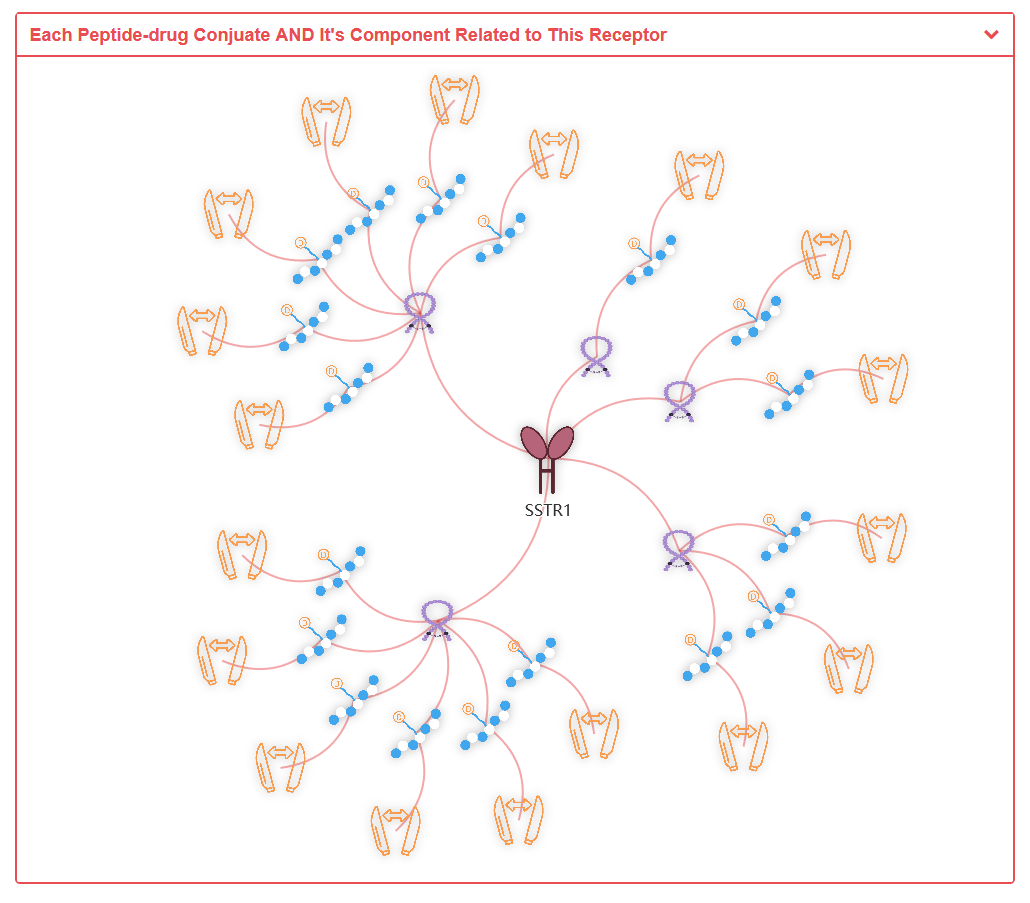
The "Full List of The PDC Related to This Receptor" section systematically reveals the peptide with this receptor. The list shows the different PDCs and the stage of research. User can get an overview of the different levels of activity data for each PDC, or easily jump to the corresponding PDC and Peptide by clicking on PDC Info and Peptide Info.
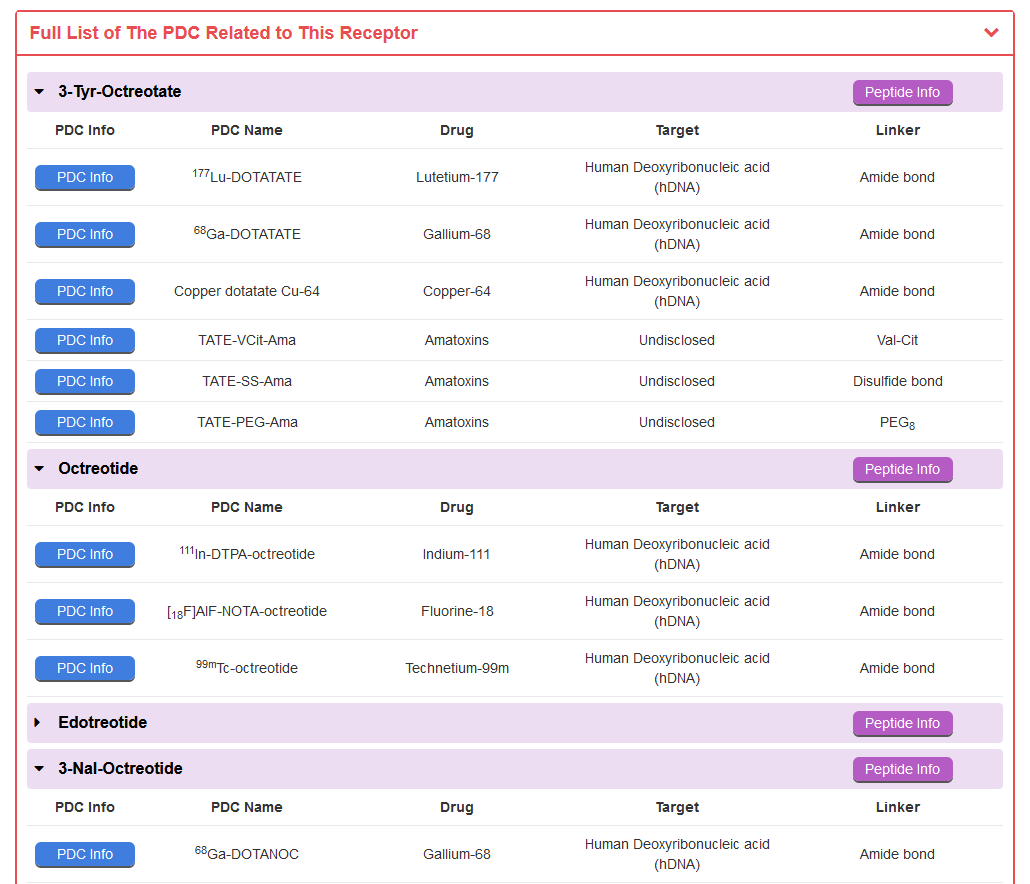
2.2. By clicking the “PDC Info” button, the detailed information page for particular PDCwill be displayed
Take Debio-0328 as an example, “General Information of This Peptide-Drug Conjugate (PDC)” section displays the general information of Debio-0328 including its ID, Name, Status, Indication, Structure, Peptide Name, Receptor Name, Drug Name, Therapeutic Target, Linker Name, and several Pharm-Information.
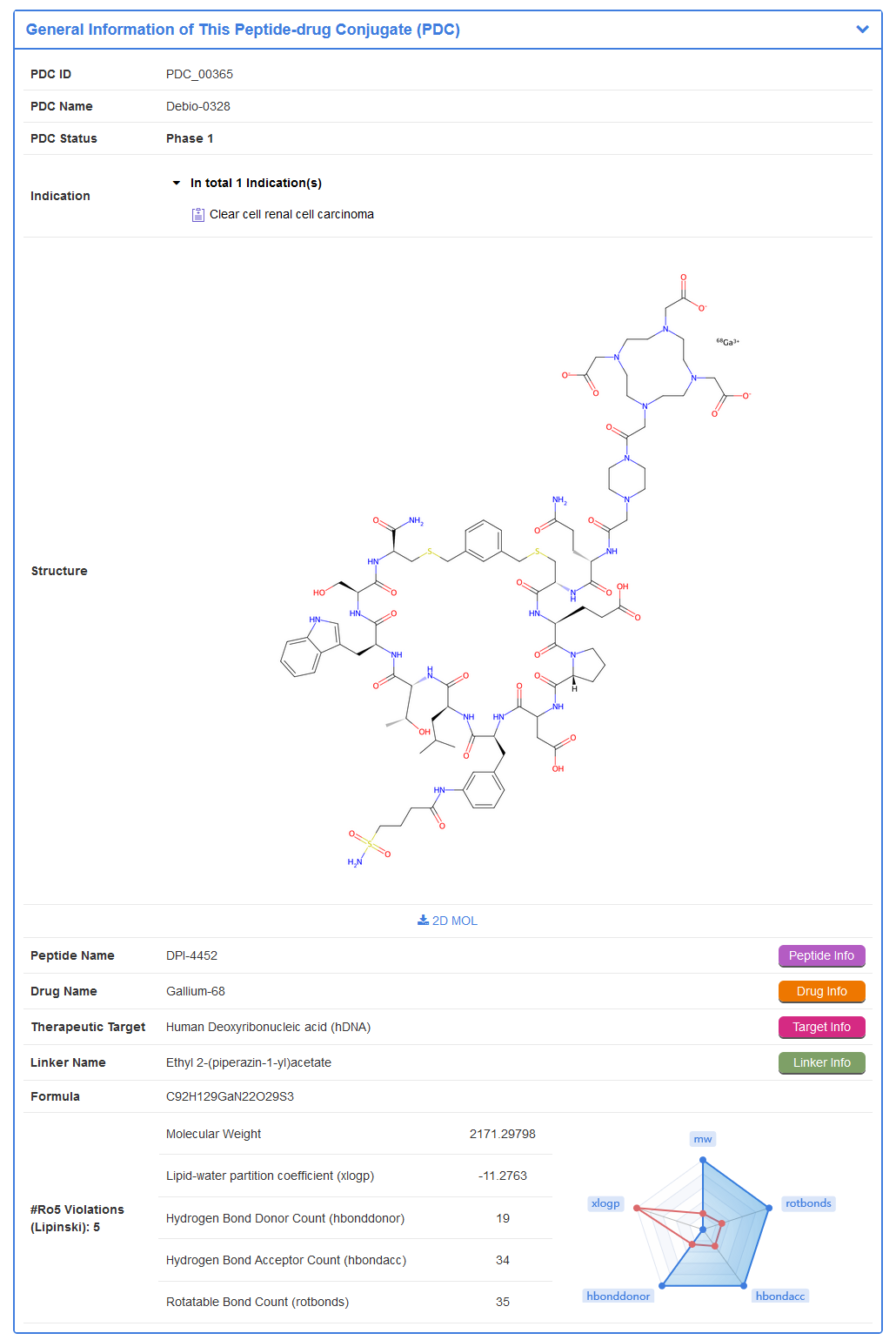
Some of the PDCs in the PDCdb have corresponding clinical study activity. The “Identified from the Human Clinical Data” section in the “Full List of The Activity Data of This Peptide-drug Conjugate” shows the Indication, Efficacy Data and Description.

2.3. By clicking the “Drug Info” button, the detailed drug information page for will be displayed
Take Temozolomide as an example, “General Information of This Drug” section displays the general information of drug, including its ID, Name, Synonyms, Target(s), Structure, Formula, Canonical smiles, PubChem CID, InChI, InChIKey, IUPAC Name, Pharmaceutical Properties and External Link(s). It is important to note that Pharmaceutical Properties is calculated by RDKit.
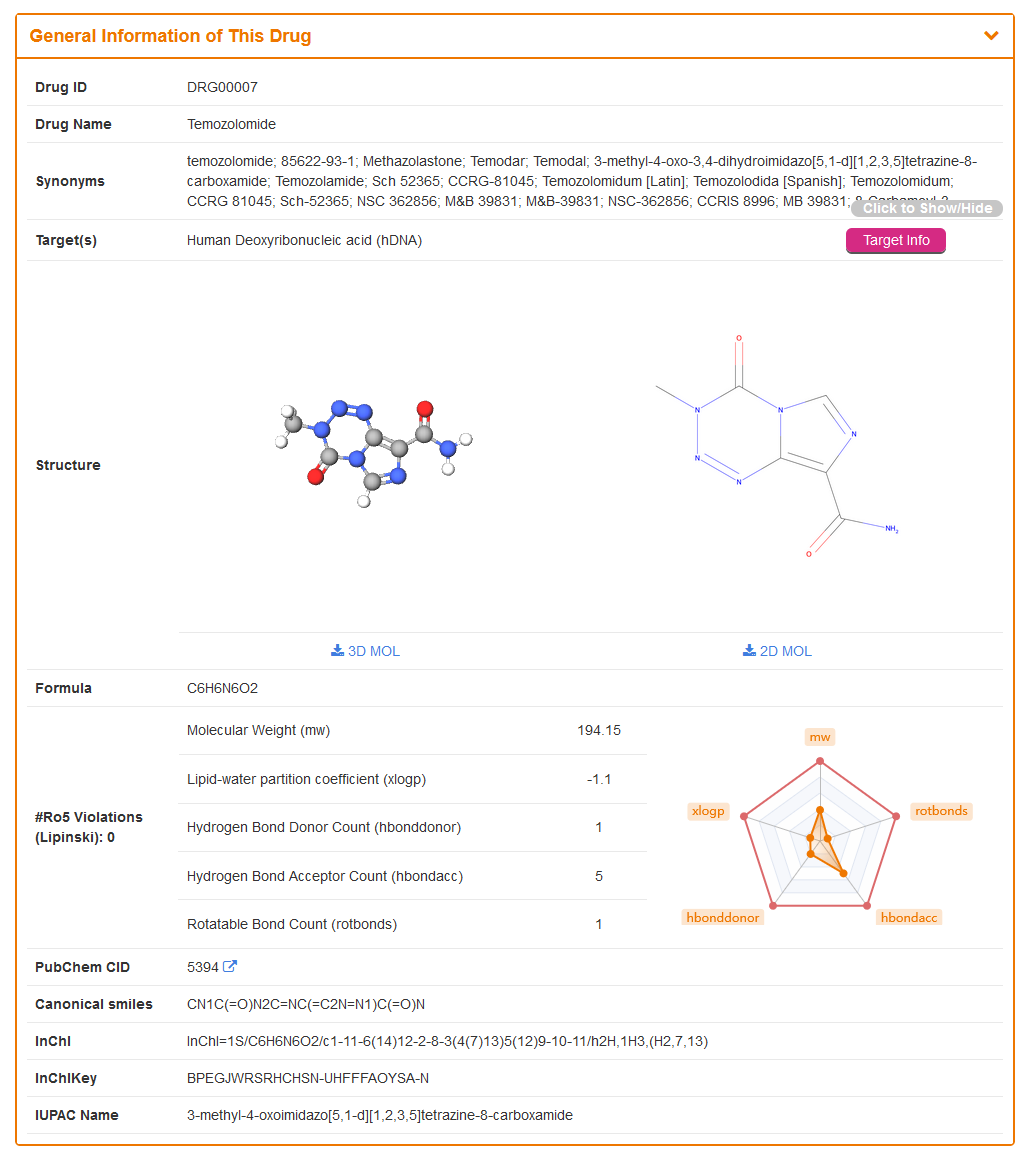
Some of the drugs in the PDCdb have corresponding single-use activities in vitro. The “The Activity Data of This Drug” section shows the Standard Type, Value, Cell line and Cell line ID.

"Each Peptide-drug Conjugate Related to This Drug" section displays the PDCs associated with this drug, with each button provided jumping to the corresponding PDC page.
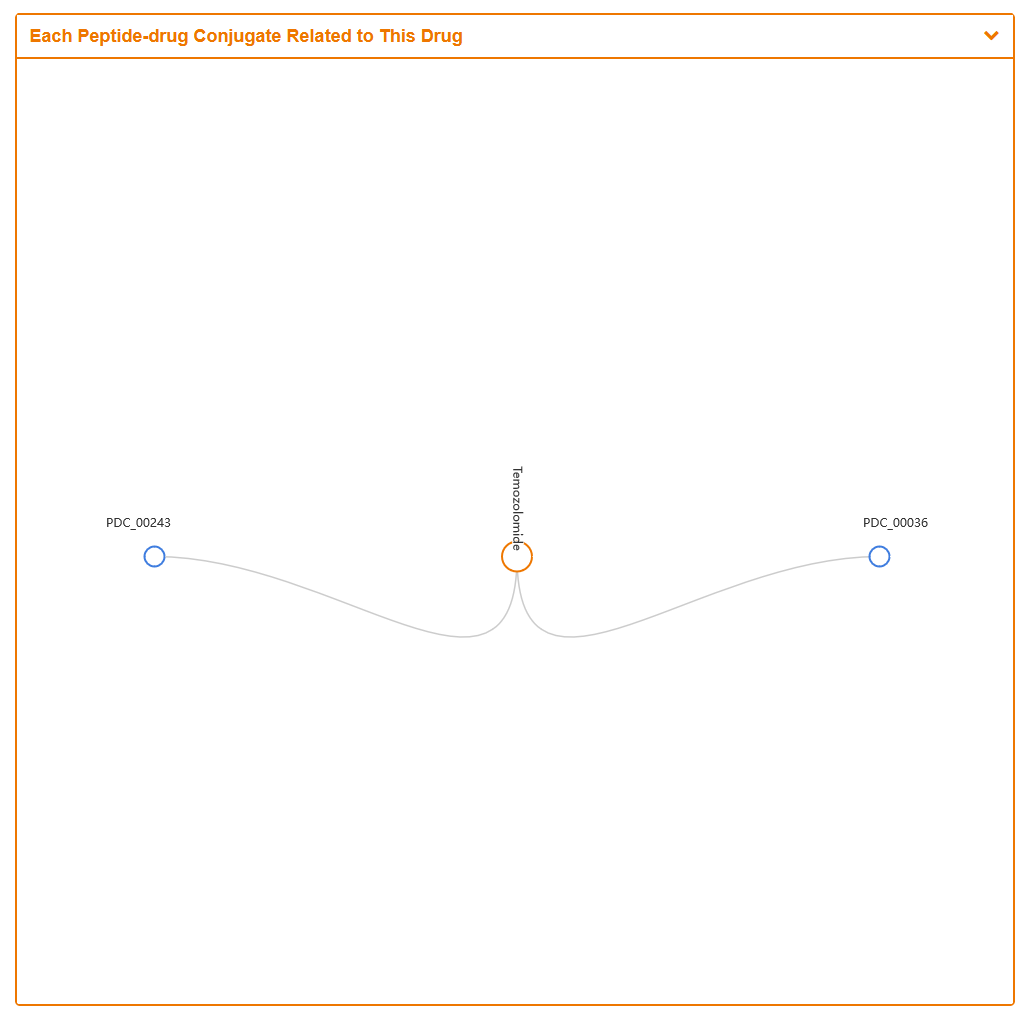
The "Full Information of The Activity Data of The PDC(s) Related to This Drug" section systematically reveals the PDCs conjugated with this drug. The list shows the different PDCs and the stage of research. User can get an overview of the different levels of activity data for each PDC, or easily jump to the corresponding PDC page by clicking on PDC Info.
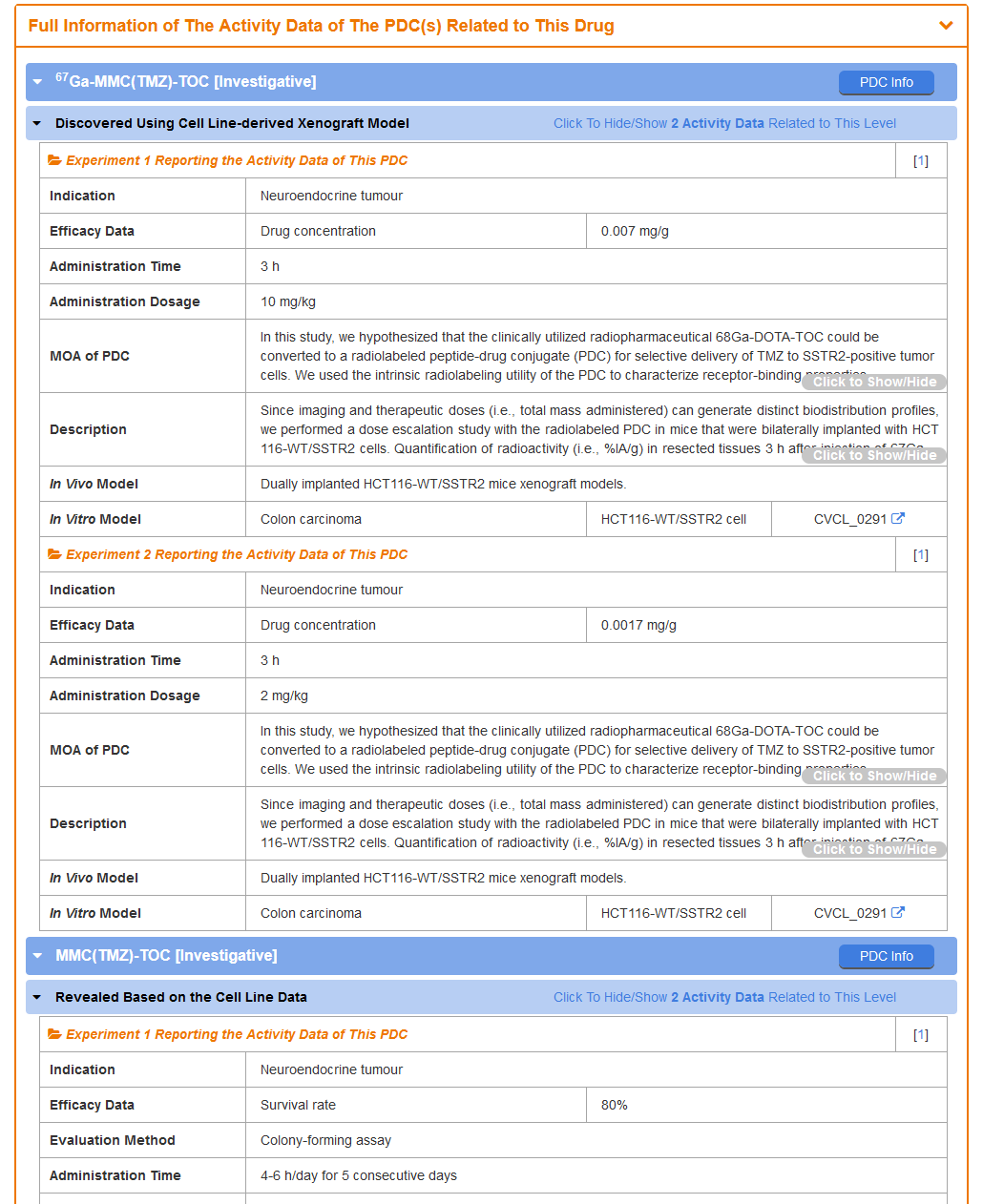
2.4. By clicking the “Linker Info” button, the detailed linker information page for will be displayed
Take Succinic Acid as an example, “General Information of This Linker” section displays the general information of linker, including its ID, Name, Linker Type, Structure, Formula, Canonical smiles, PubChem CID, InChI, InChIKey, IUPAC Name, Pharmaceutical Properties and External Link(s). It is important to note that Pharmaceutical Properties is calculated by RDKit.
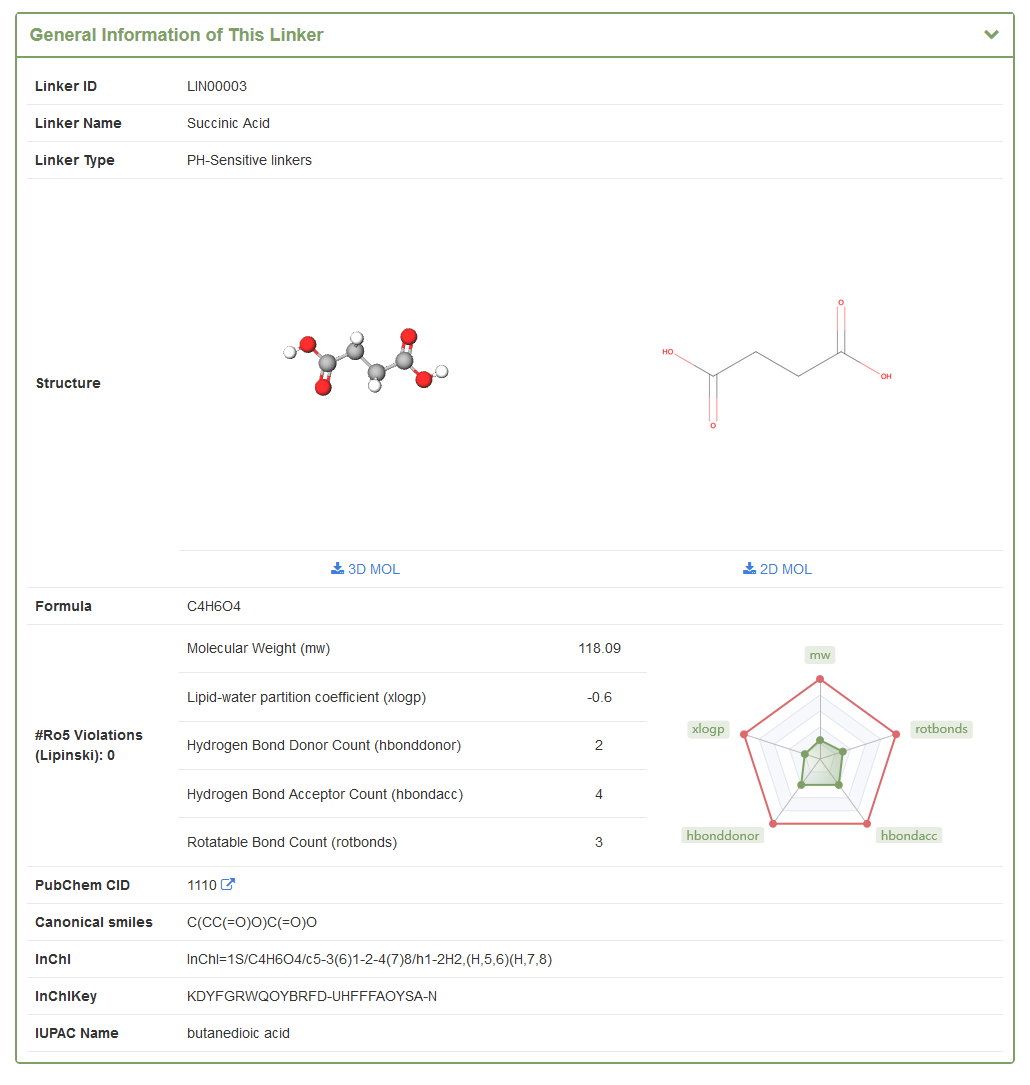
"Each Peptide-Drug Conjugate Related to This Linker" section displays the PDCs associated with this linker, with each button provided jumping to the corresponding PDC page.
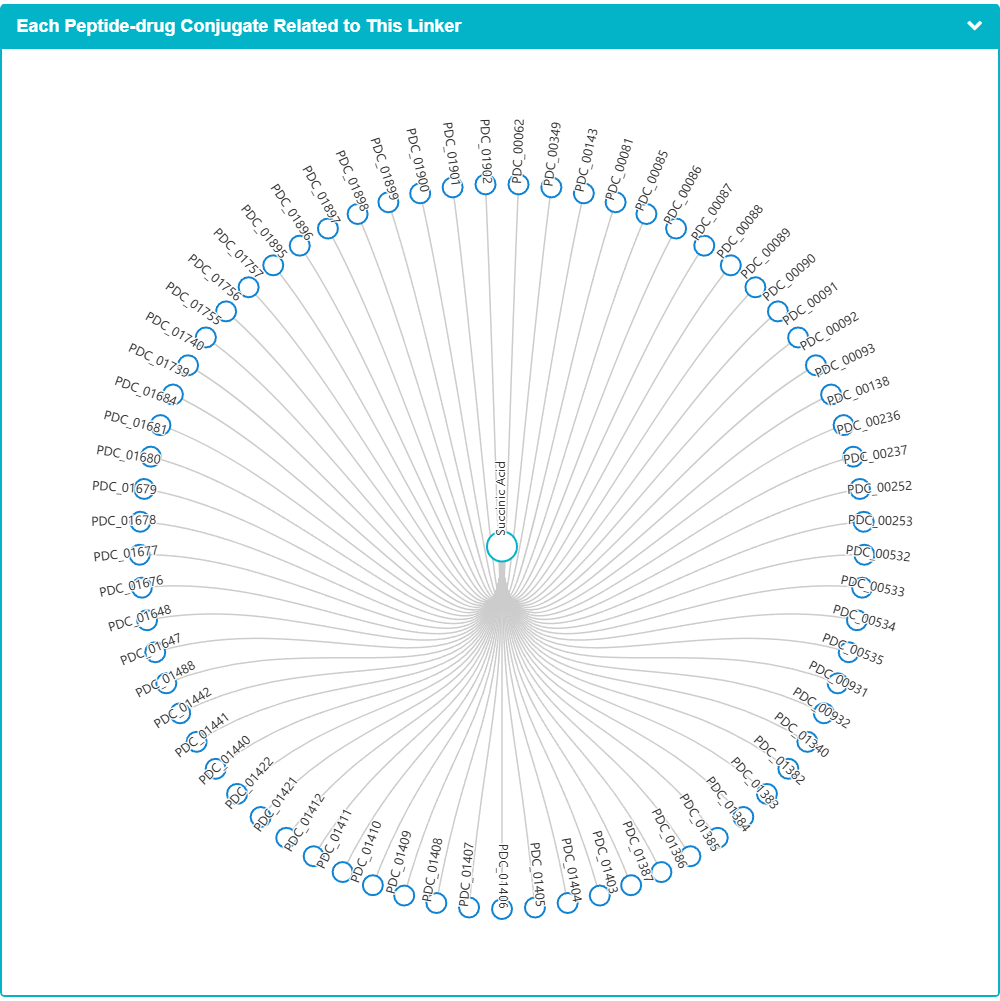
The "Full Information of The Activity Data of The PDC(s) Related to This Linker" section systematically reveals the PDCs conjugated with this linker. The list shows the different PDCs and the stage of research. User can get an overview of the different levels of activity data for each PDC, or easily jump to the corresponding PDC page by clicking on PDC Info.
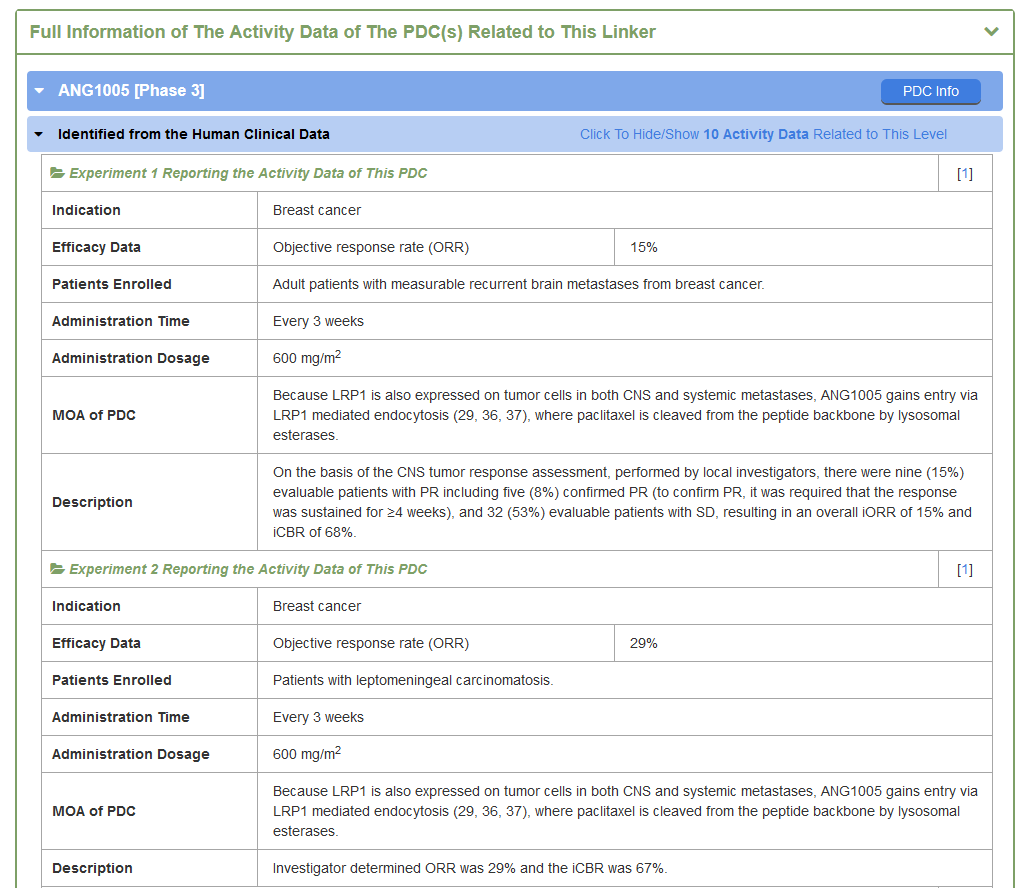
In the field of “Search for Drug, users can find drug entries by searching drug name, Related PDC, Indication, Peptide name, Linker name and so on among the entire textual component of PDCdb. Query can be submitted by entering keywords into the main searching frame. The resulting webpage displays profiles of all the peptides directly related to the search term, including Drug name, PDC name, Peptide name, Linker name and their information links.
In order to facilitate a more customized input query, the wild characters of “*” and “?” are also supported.
(1) If search Technetium-99m, find two API entries which is named Technetium-99m;
(2) If search: Technetium*”, find a single entry which is named Technetium-99m;
For example, if you want to know the detail information for Technetium-99m, you can search Technetium-99m in the “Search for Drug” field.
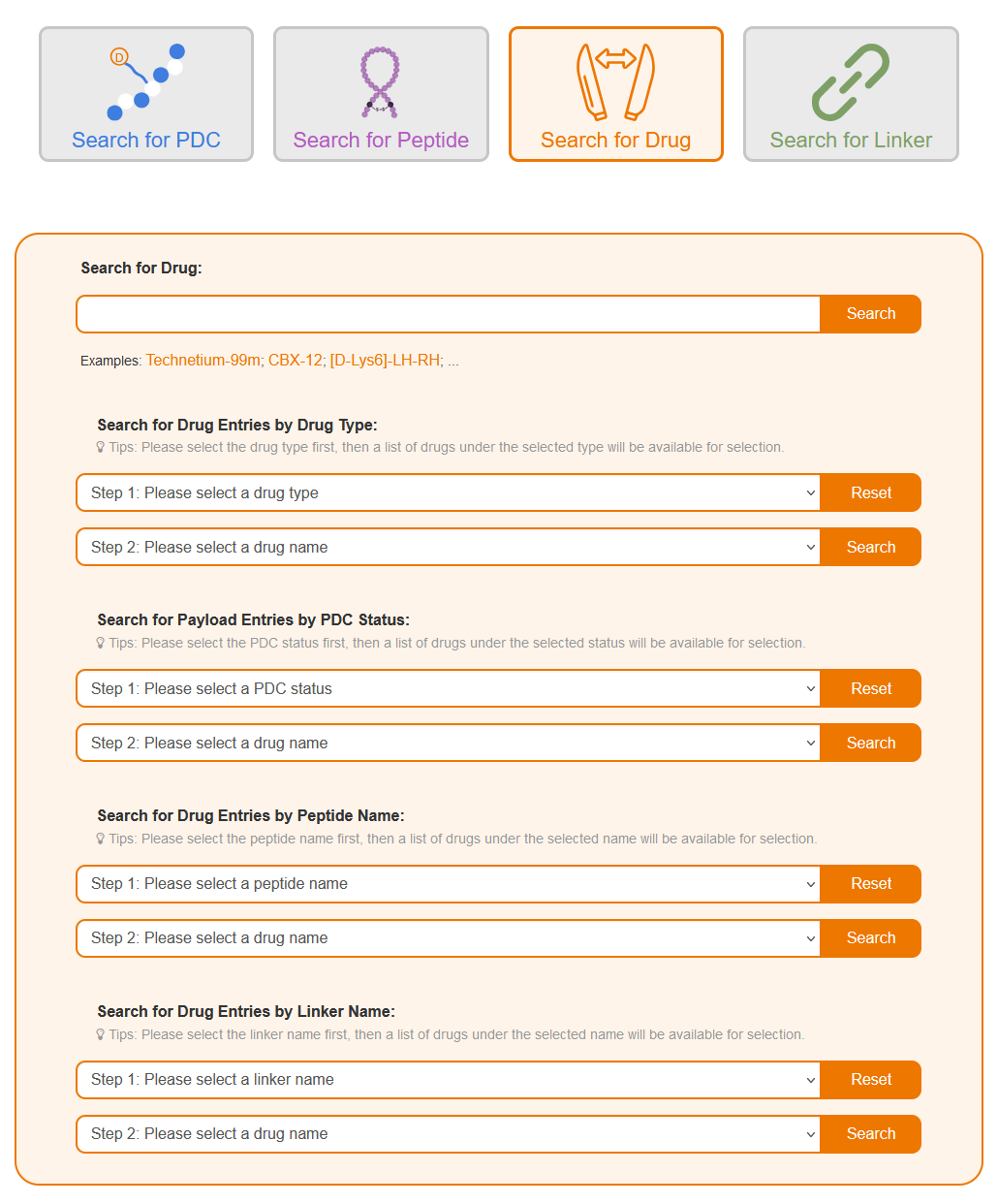
Search result of the Technetium-99m shows the information of Drug ID, Drug Name, Representative PDC, Indication, Peptide Name, Linker Name and External buttons. The “Drug Info” button links to the detailed drug information page of Technetium-99m. The “PDC Info” button links to the detailed PDC information page of 99mTc-3PRGD2. The Peptide Info” button links to the detailed peptide information page of c(RGDfK). The “Linker Info” button links to the detailed linker information page of PEG2.
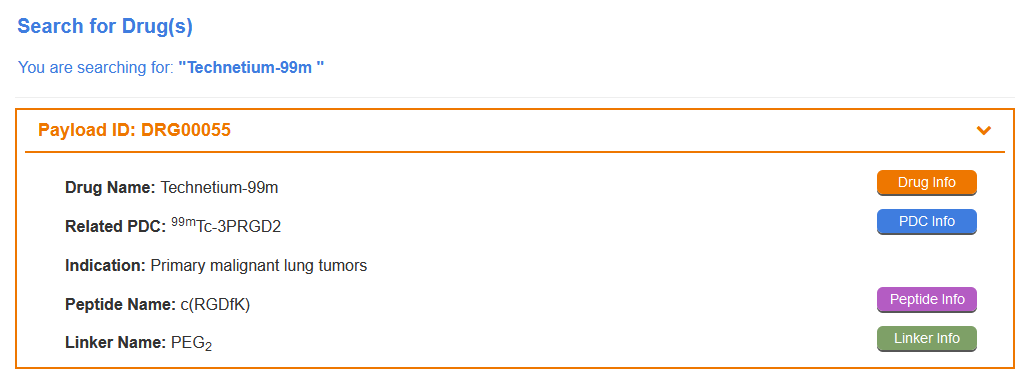
3.1. By clicking the “Drug Info” button, the detailed drug information page for will be displayed
Take Technetium-99m as an example, “General Information of This Drug” section displays the general information of drug, including its ID, Name, Synonyms, Target(s), Structure, Formula, Canonical smiles, PubChem CID, InChI, InChIKey, IUPAC Name, Pharmaceutical Properties and External Link(s). It is important to note that Pharmaceutical Properties is calculated by RDKit.
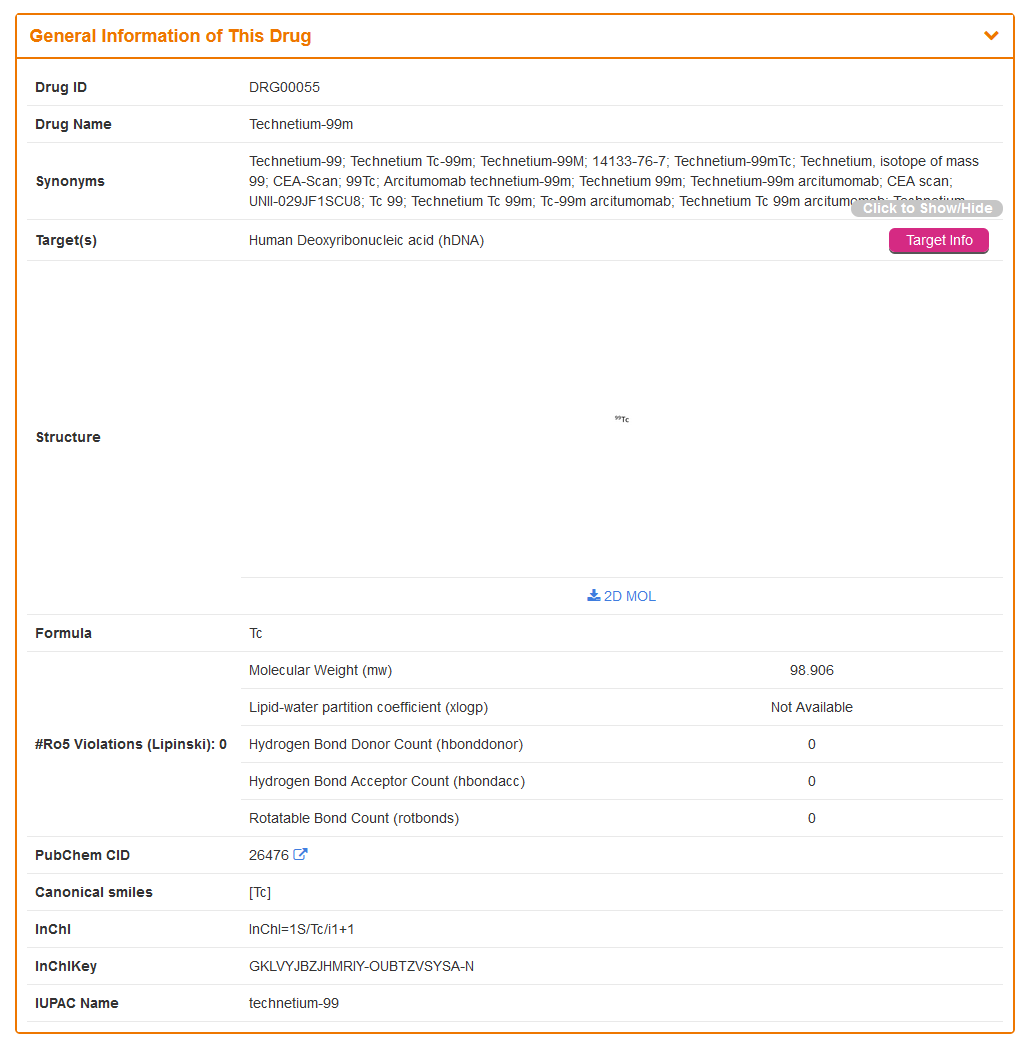
By clicking the “Target Info” button, the detailed target information page will be displayed.
Take Microtubule (MT) as an example, “General Information of This Target" section displays the general information of drug, including its ID, Name, Function.

The "Full List of The PDC Related to This Target" section systematically reveals the PDC with this target. The list shows the different PDCs and the stage of research. User can get an overview of the different levels of activity data for each PDC, or easily jump to the corresponding PDC by clicking on PDC Info.
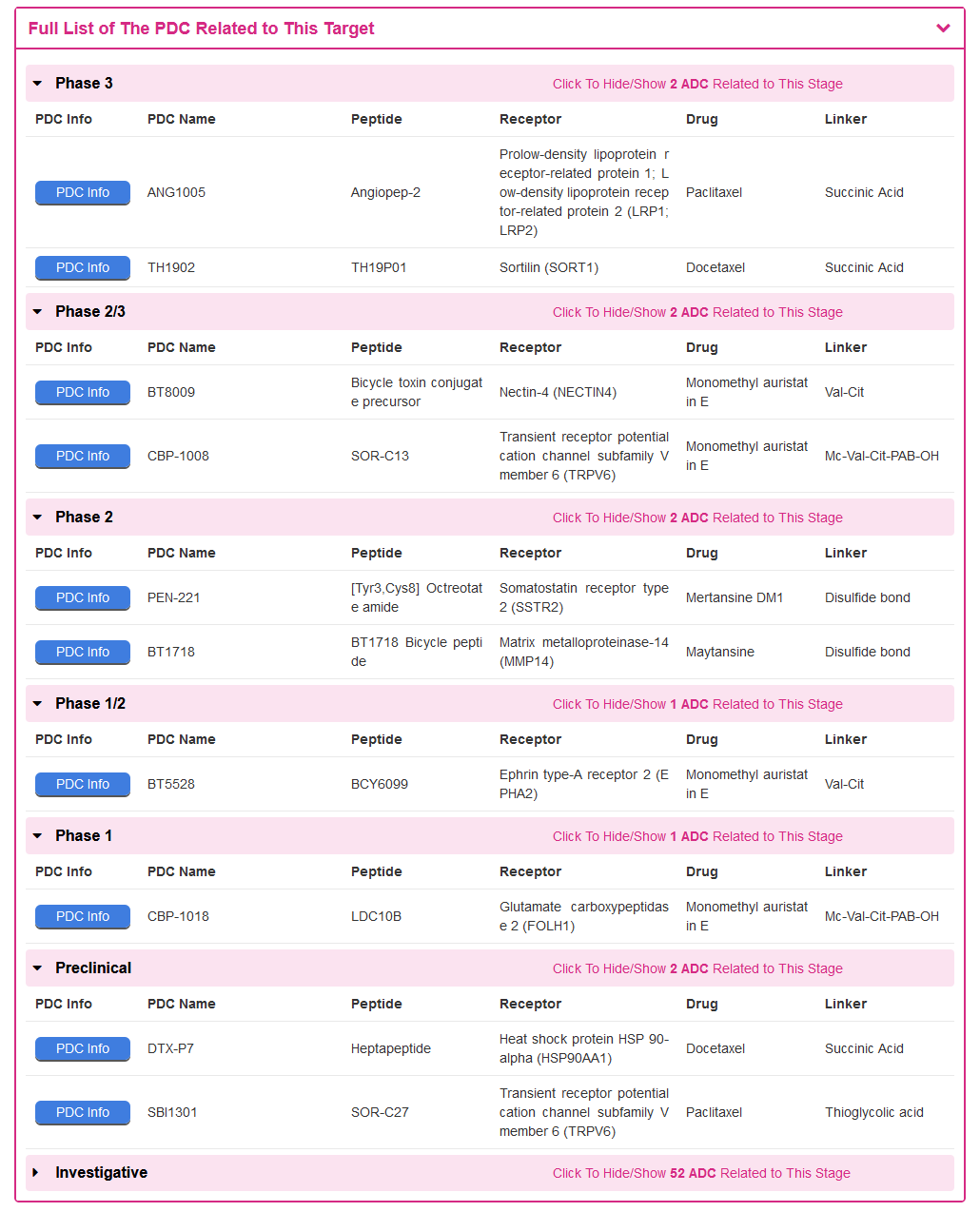
"Each Peptide-drug Conjugate Related to This Drug" section displays the PDCs associated with this drug, with each button provided jumping to the corresponding PDC page.
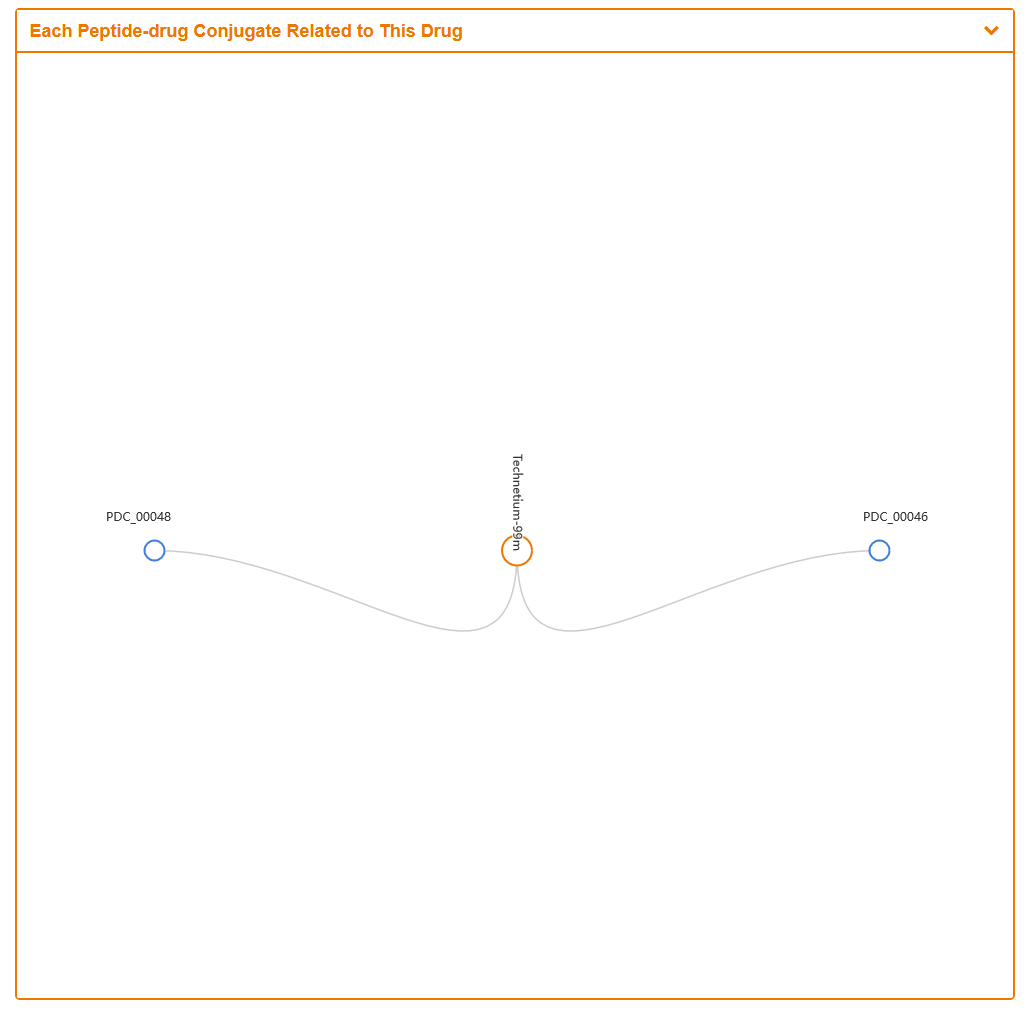
The "Full Information of The Activity Data of The PDC(s) Related to This Drug" section systematically reveals the PDCs conjugated with this drug. The list shows the different PDCs and the stage of research. User can get an overview of the different levels of activity data for each PDC, or easily jump to the corresponding PDC page by clicking on PDC Info.
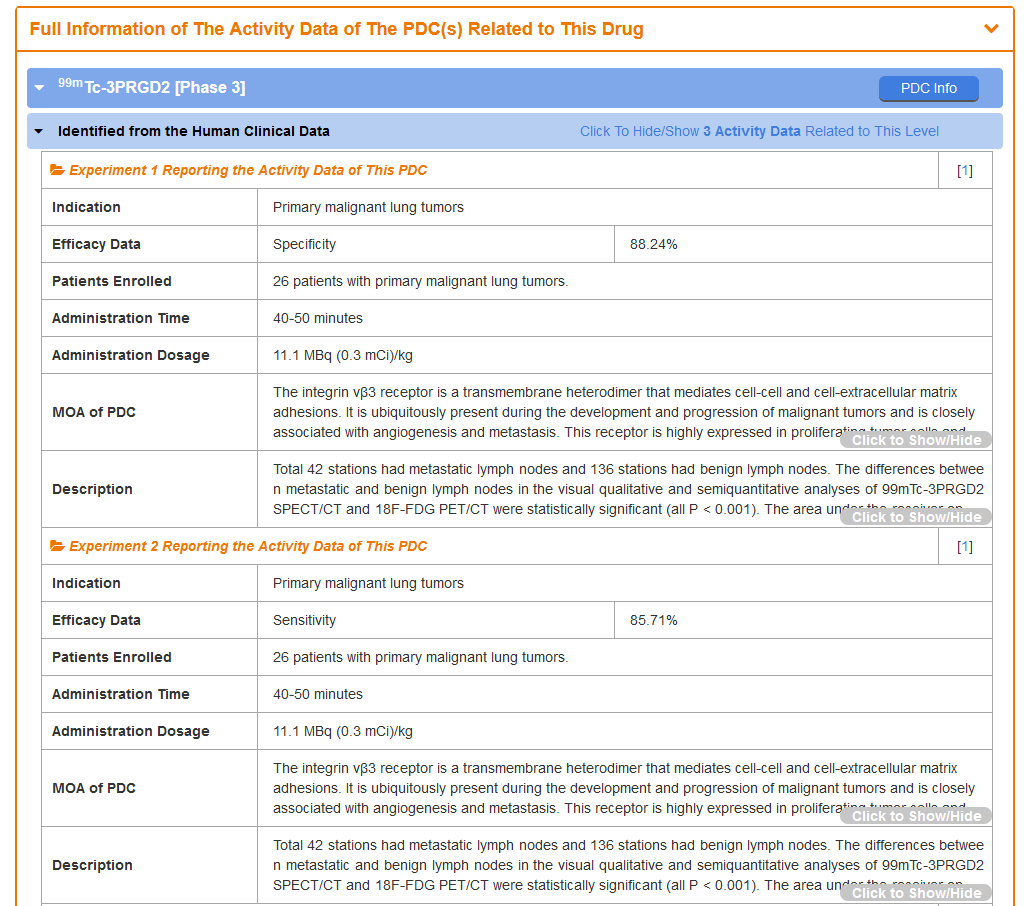
3.2. By clicking the “PDC Info” button, the detailed information page for particular PDCwill be displayed
Take 99mTc-3PRGD2 as an example, “General Information of This Peptide-Drug Conjugate (PDC)” section displays the general information of 99mTc-3PRGD2 including its ID, Name, Status, Indication, Peptide Modified Type, Modified Segment, Structure, Peptide Name, Structure, Receptor Name, Drug Name, Therapeutic Target, Linker Name, Drugbank ID, Pharm-Information and External Link(s). In addition, this section displays the general information of 99mTc-3PRGD2 including its PDC Name, Peptide Name, Receptor Name, Drug Name, Linker Name, and Indication(s).
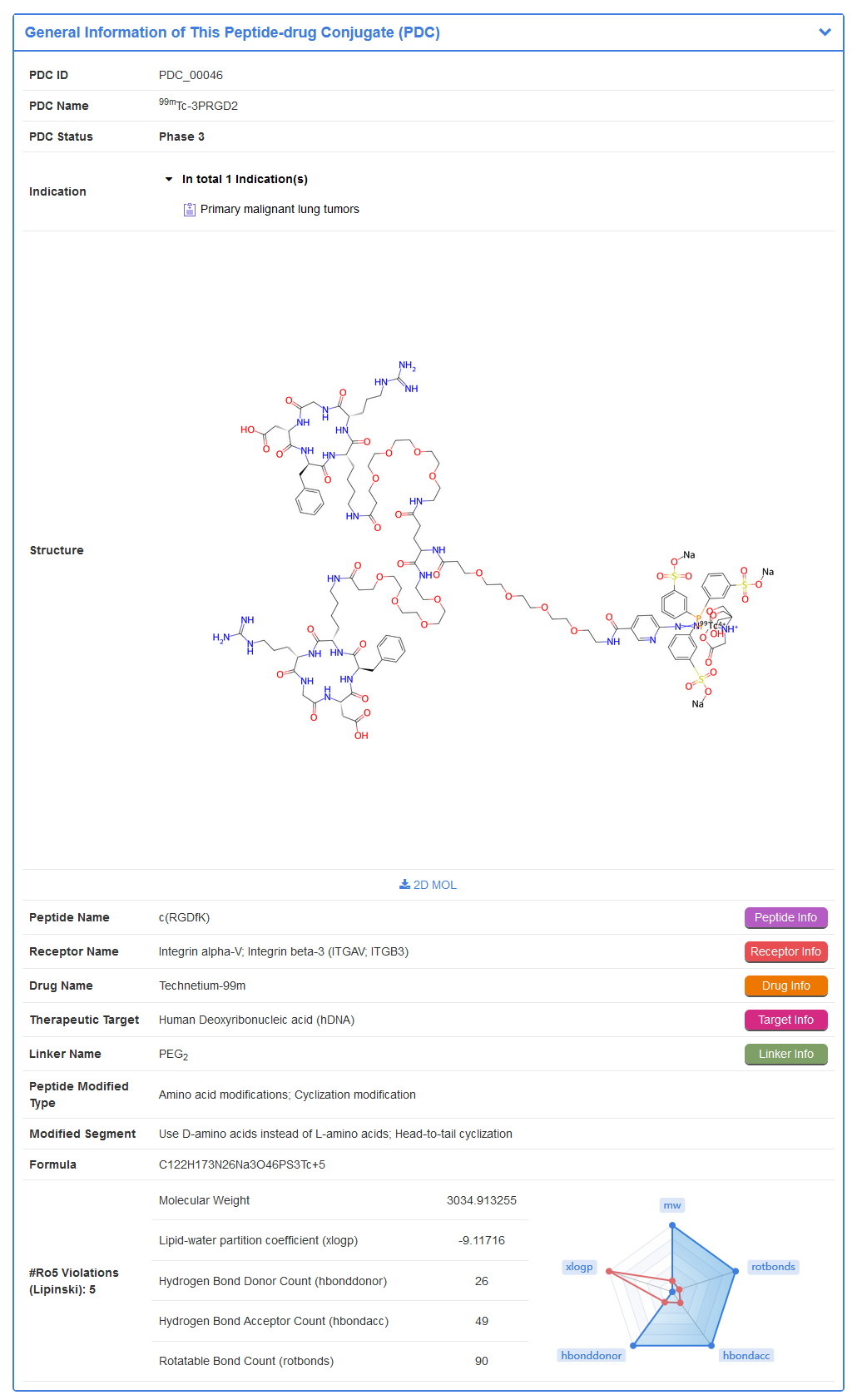
Some of the PDCs in the PDCdb have corresponding clinical study activity. The “Identified from the Human Clinical Data” section in the “Full List of The Activity Data of This Peptide-drug Conjugate” shows the Indication, Efficacy Data and Description.

3.3. By clicking the Peptide Info” button, the detailed peptide information page will be displayed
Take c(RGDfK) as an example, “General Information of This Peptide” section displays the general information of peptide, including its Name, Sequence, Peptide Type, Receptor Name, PDC Transmembrane Types, Distributionand External Link(s).

"Each Peptide-drug Conjugate Related to This Peptide" section displays the PDCs associated with this peptide, with each button provided jumping to the corresponding PDC page.
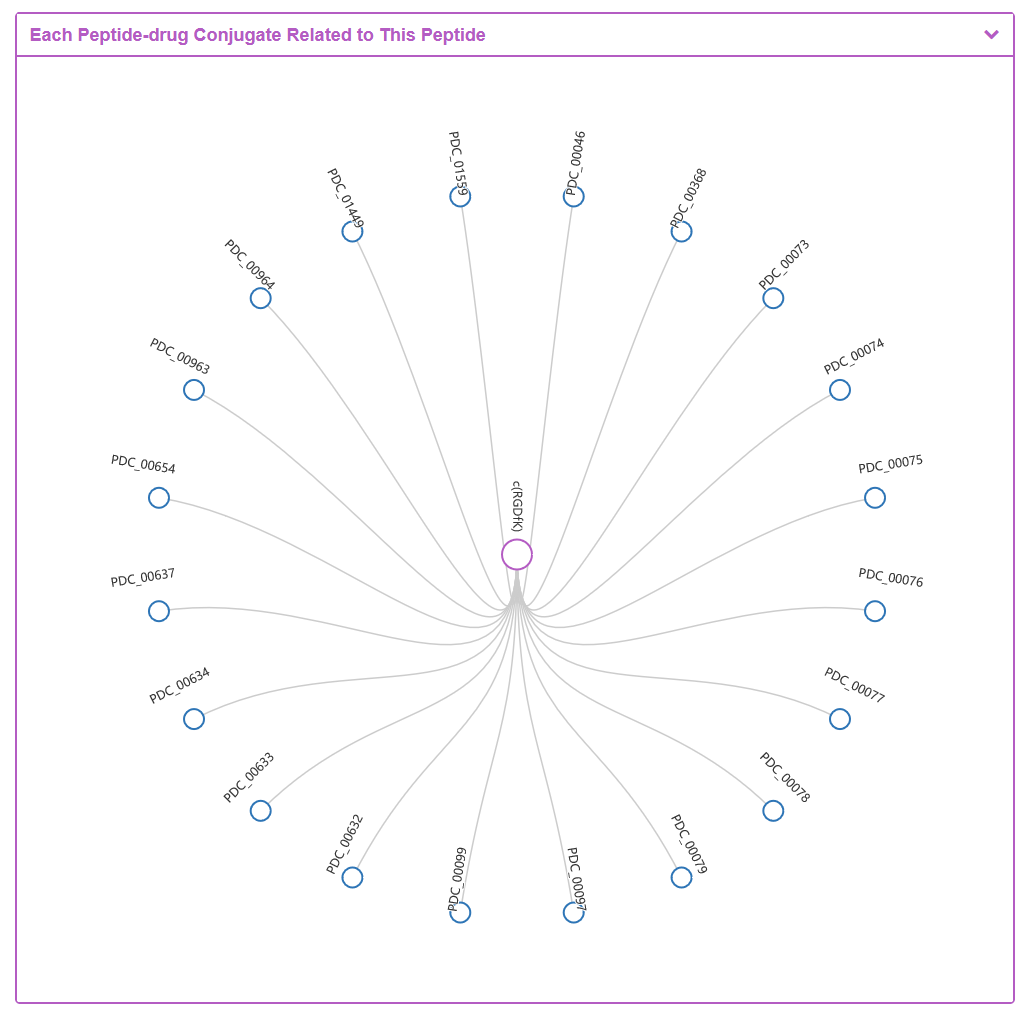
The "Full Information of The Activity Data of The PDC(s) Related to This Peptide" section systematically reveals the PDCs conjugated with this peptide. The list shows the different PDCs and the stage of research. User can get an overview of the different levels of activity data for each PDC, or easily jump to the corresponding PDC page by clicking on PDC Info.
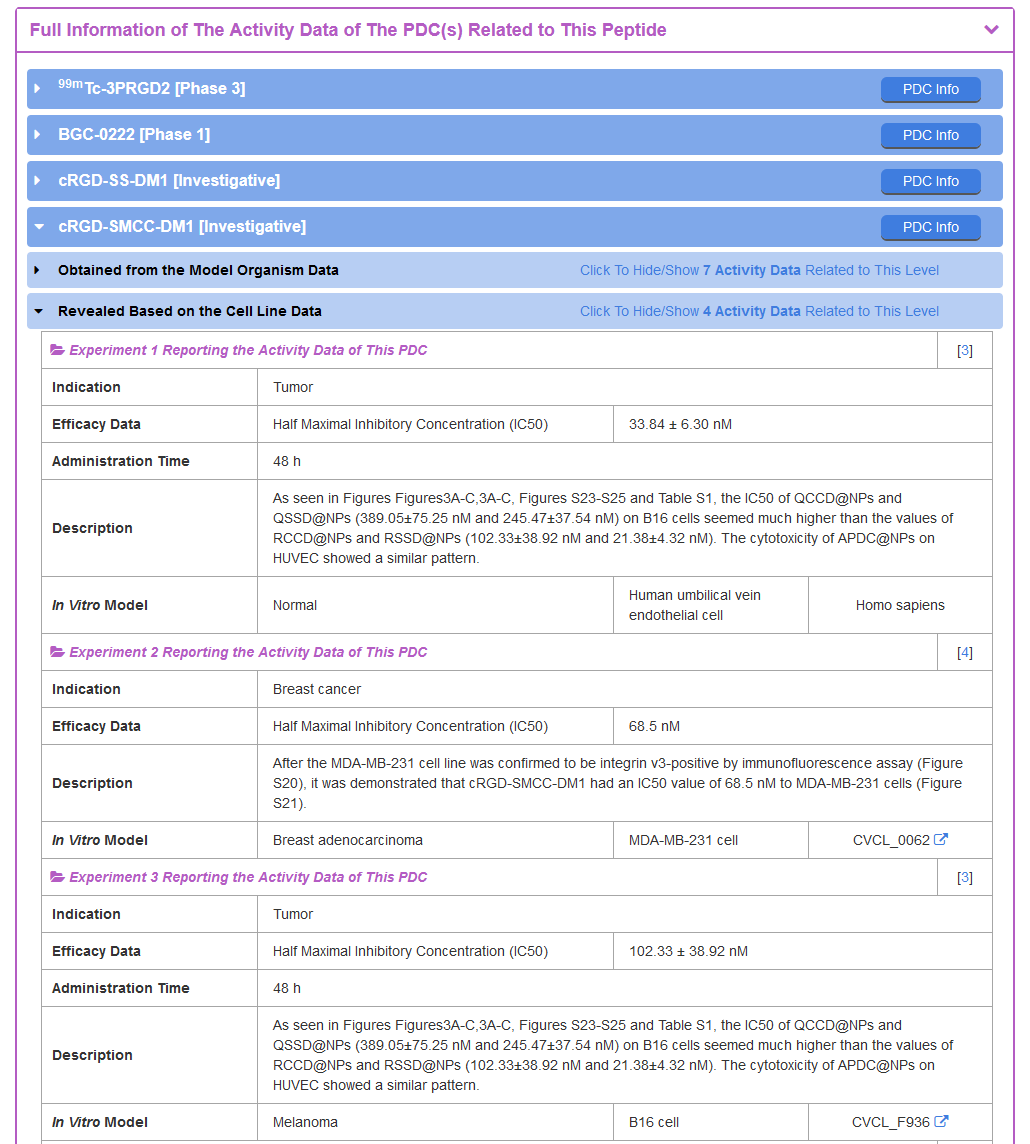
3.4. By clicking the “Linker Info” button, the detailed linker information page for will be displayed.
Take PEG2 as an example, “General Information of This Linker” section displays the general information of linker, including its ID, Name, Linker Type, Structure, Formula, Canonical smiles, PubChem CID, InChI, InChIKey, IUPAC Name, Pharmaceutical Properties and External Link(s). It is important to note that Pharmaceutical Properties is calculated by RDKit.
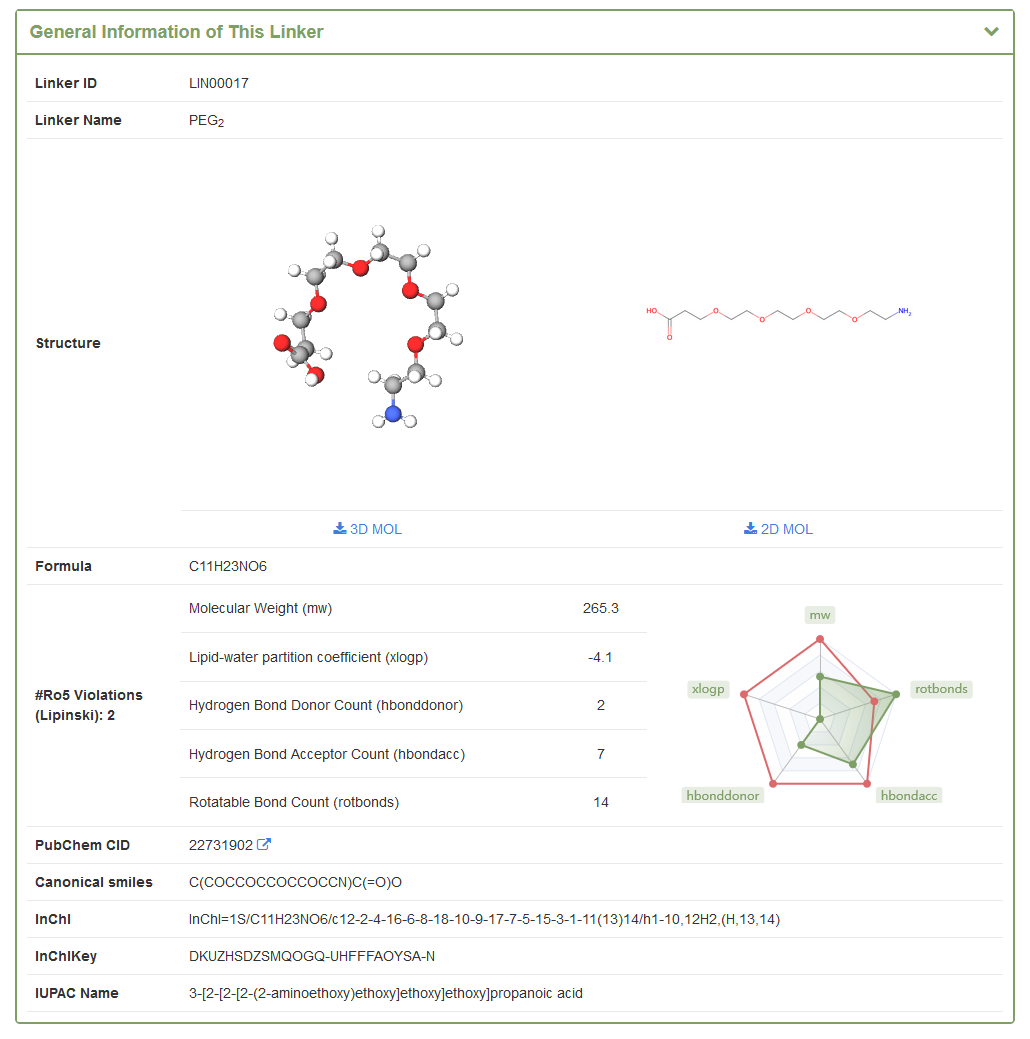
"Each Peptide-drug Conjugate Related to This Linker" section displays the PDCs associated with this linker, with each button provided jumping to the corresponding PDC page.
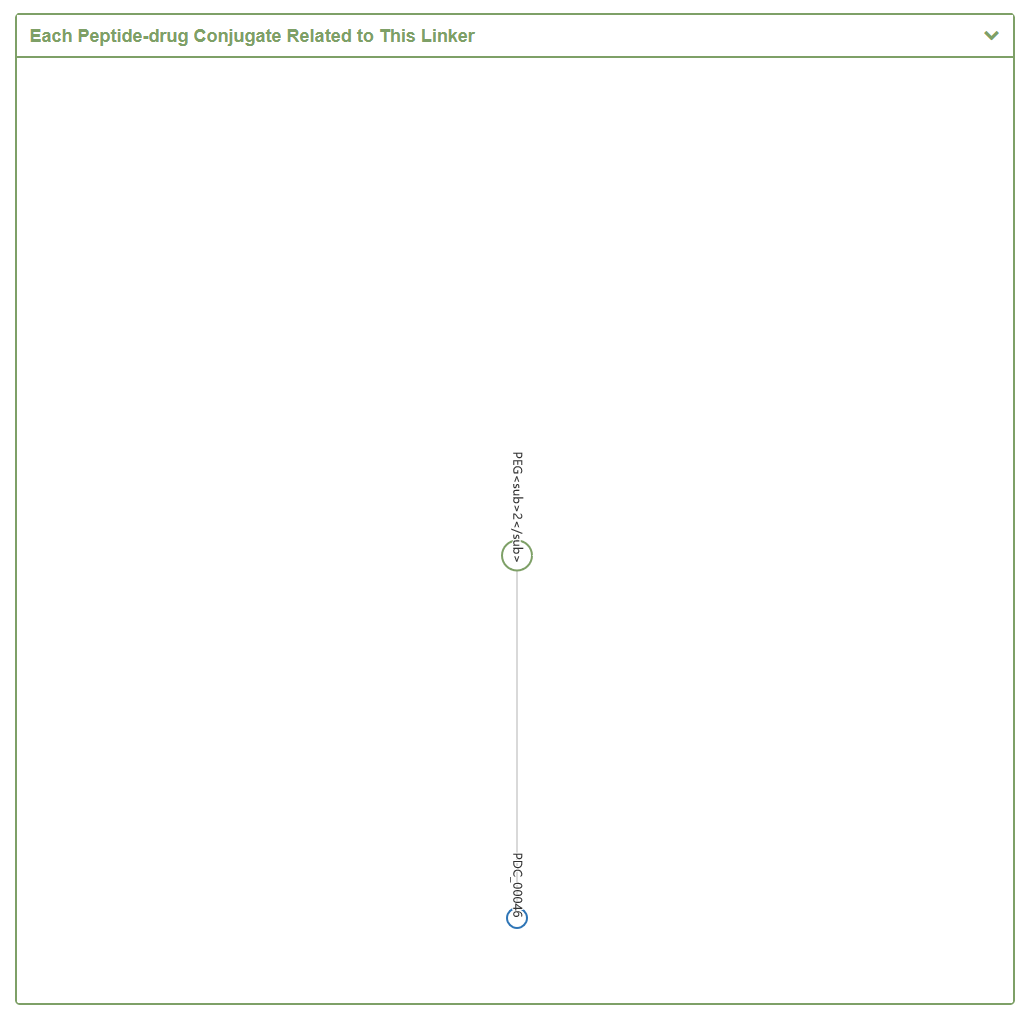
The "Full Information of The Activity Data of The PDC(s) Related to This Linker" section systematically reveals the PDCs conjugated with this linker. The list shows the different PDCs and the stage of research. User can get an overview of the different levels of activity data for each PDC, or easily jump to the corresponding PDC page by clicking on PDC Info.
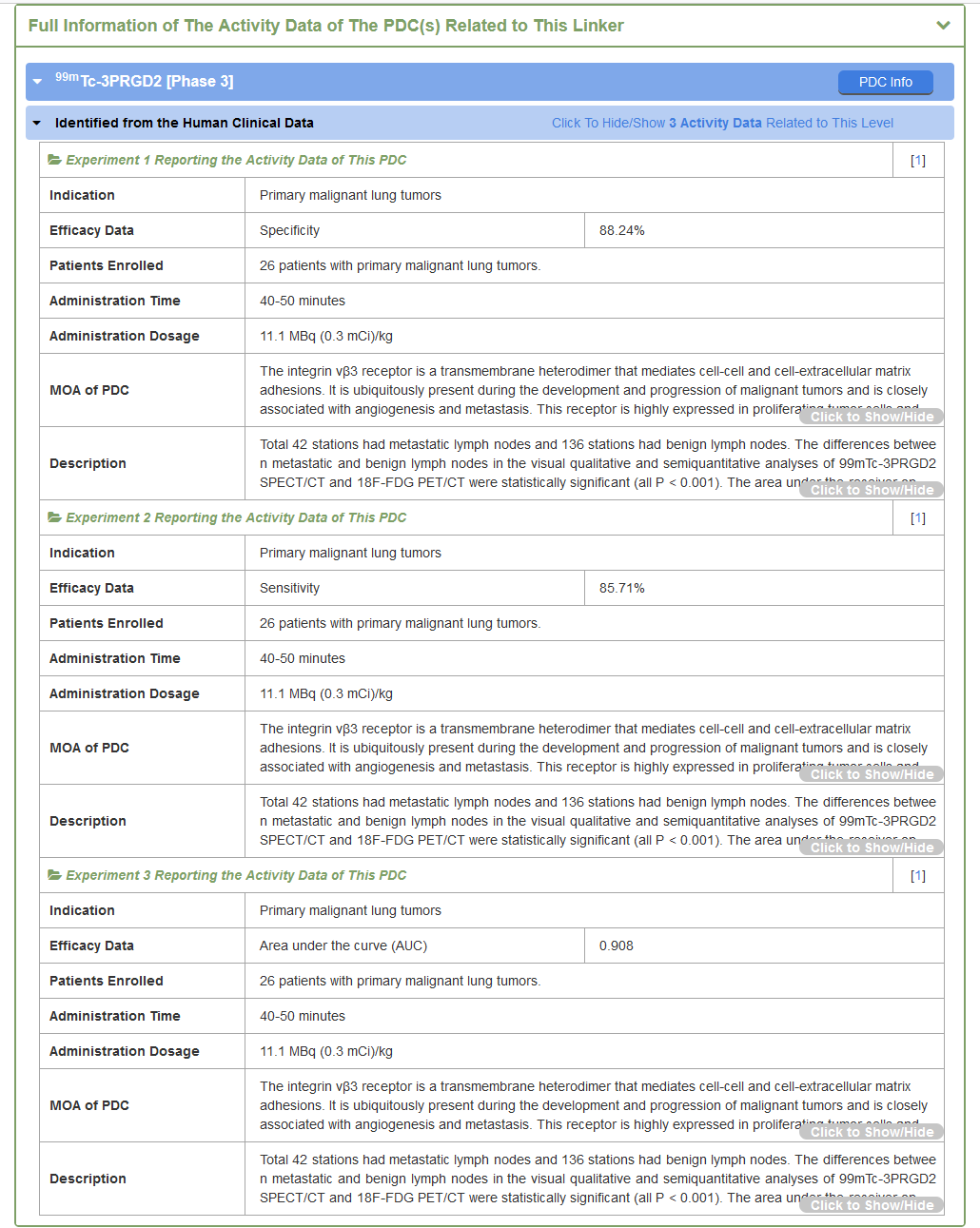
In the field of “Search for Linker”, users can find linker entries by searching linker name, PDC name, Indication, peptide name, PDC name, Drug name, and so on among the entire textual component of PDCdb. Query can be submitted by entering keywords into the main searching frame. The resulting webpage displays profiles of all the Linkers directly related to the search term, including Linker ID, Linker name, PDC name, Peptide name, Drug name and their information links.
In order to facilitate a more customized input query, the wild characters of “*” and “?” are also supported.
(1) If search “Succinic Acid”, find a single API entry which are named “Succinic Acid”;
(2) If search: “Succinic Aci*”, find one entry which are named “Succinic Acid”;
For example, if you want to know the detail information for Succinic Acid, you can search “Succinic Acid” in the “Search for Linker” field.
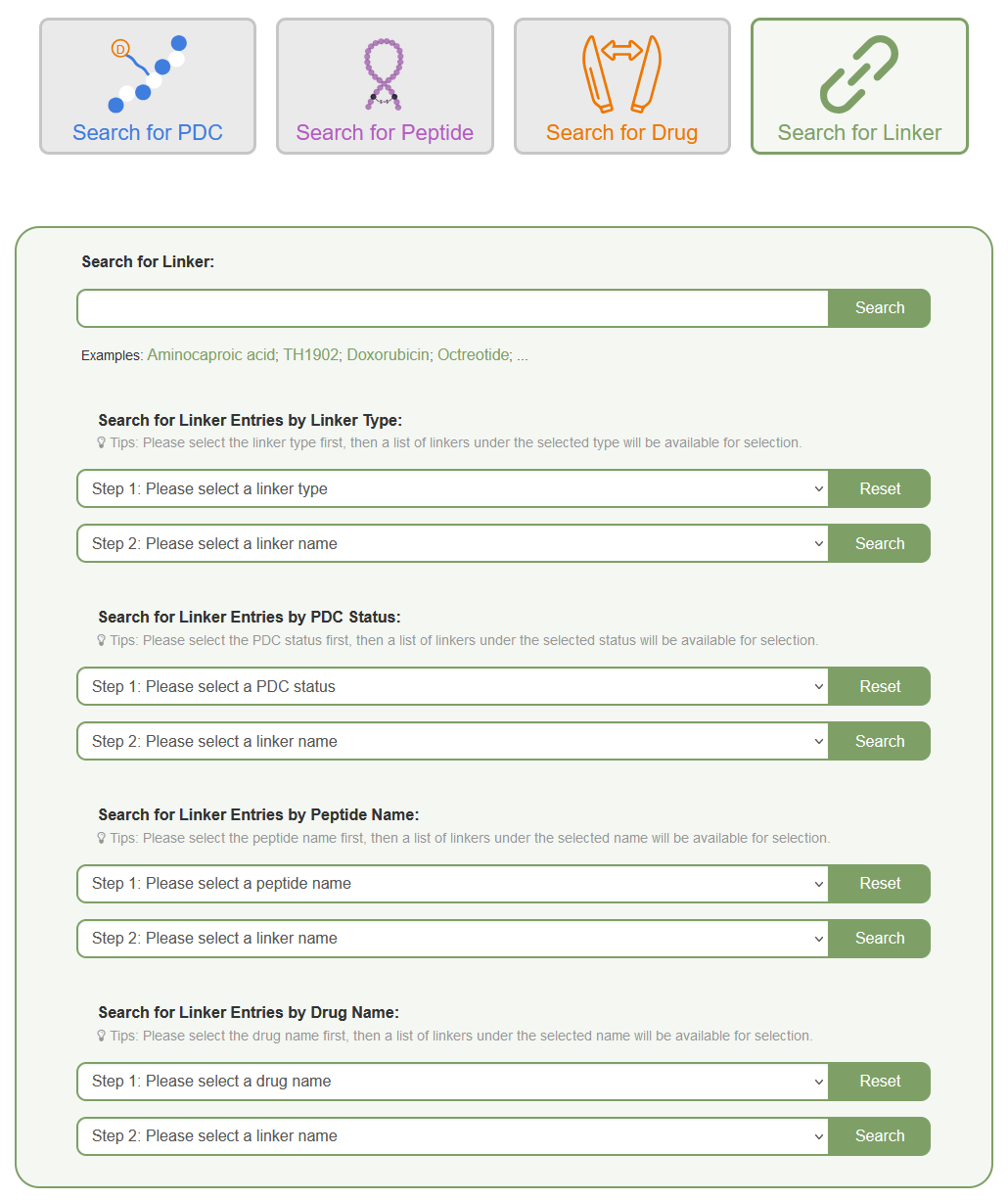
Search result of the “TH1902” shows the information of Linker ID, Linker Name, PDC Name, Indication, Peptide Name, Drug Name and External buttons. The “Linker Info” button links to the detailed linker information page of Succinic Acid. The “PDC Info” button links to the detailed PDC information page of TH1902. The “Peptide Info” button links to the detailed peptide information page of TH19P01. The “Drug Info” button links to the detailed drug information page of Docetaxel.
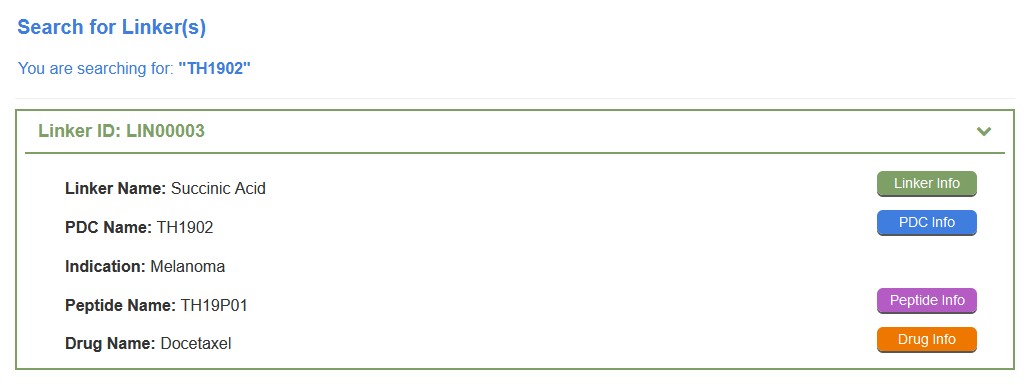
4.1. By clicking the “Linker Info” button, the detailed linker information page for will be displayed.
Take Succinic Acid as an example, “General Information of This Linker” section displays the general information of linker, including its ID, Name, Linker Type, Structure, Formula, Canonical smiles, PubChem CID, InChI, InChIKey, IUPAC Name, Pharmaceutical Properties and External Link(s). It is important to note that Pharmaceutical Properties is calculated by RDKit.
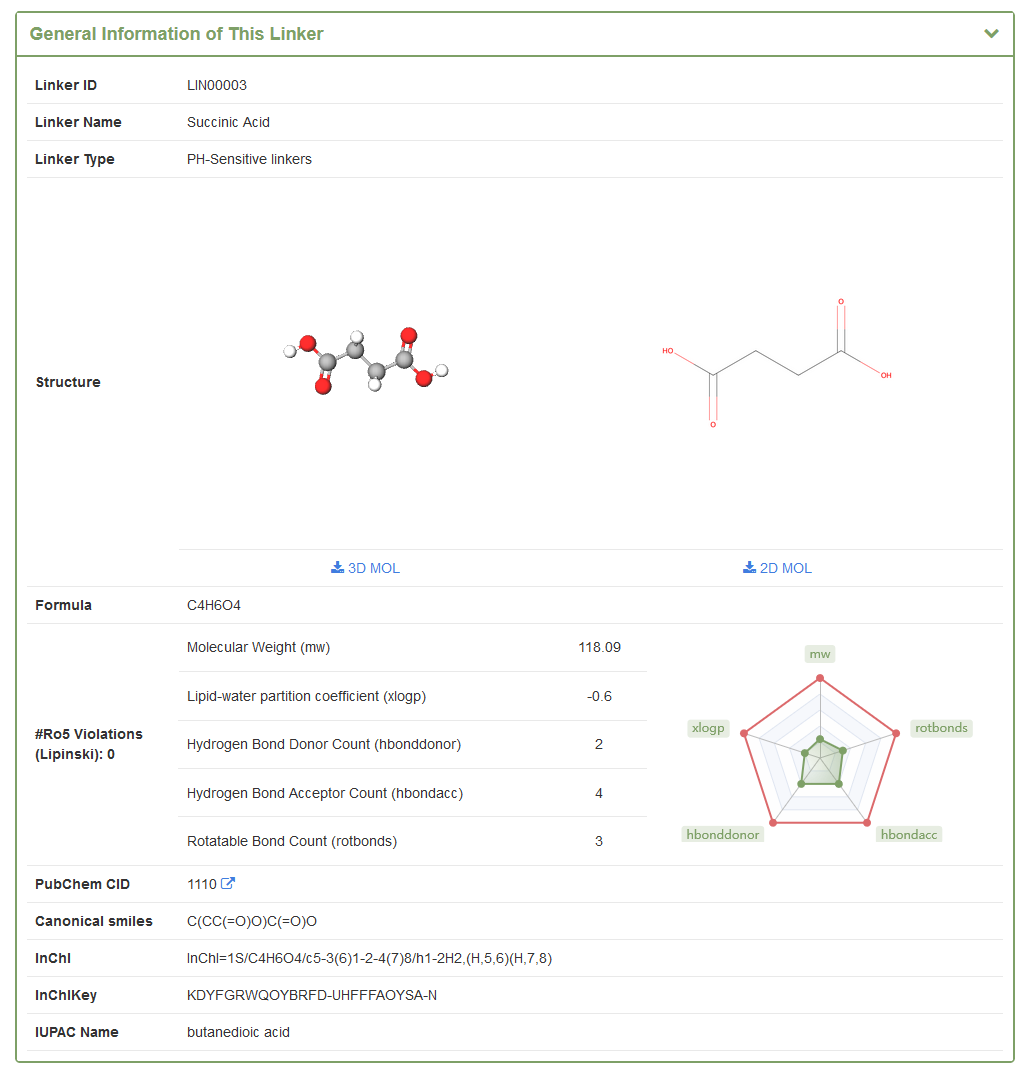
"Each Peptide-drug Conjugate Related to This Linker" section displays the PDCs associated with this linker, with each button provided jumping to the corresponding PDC page.
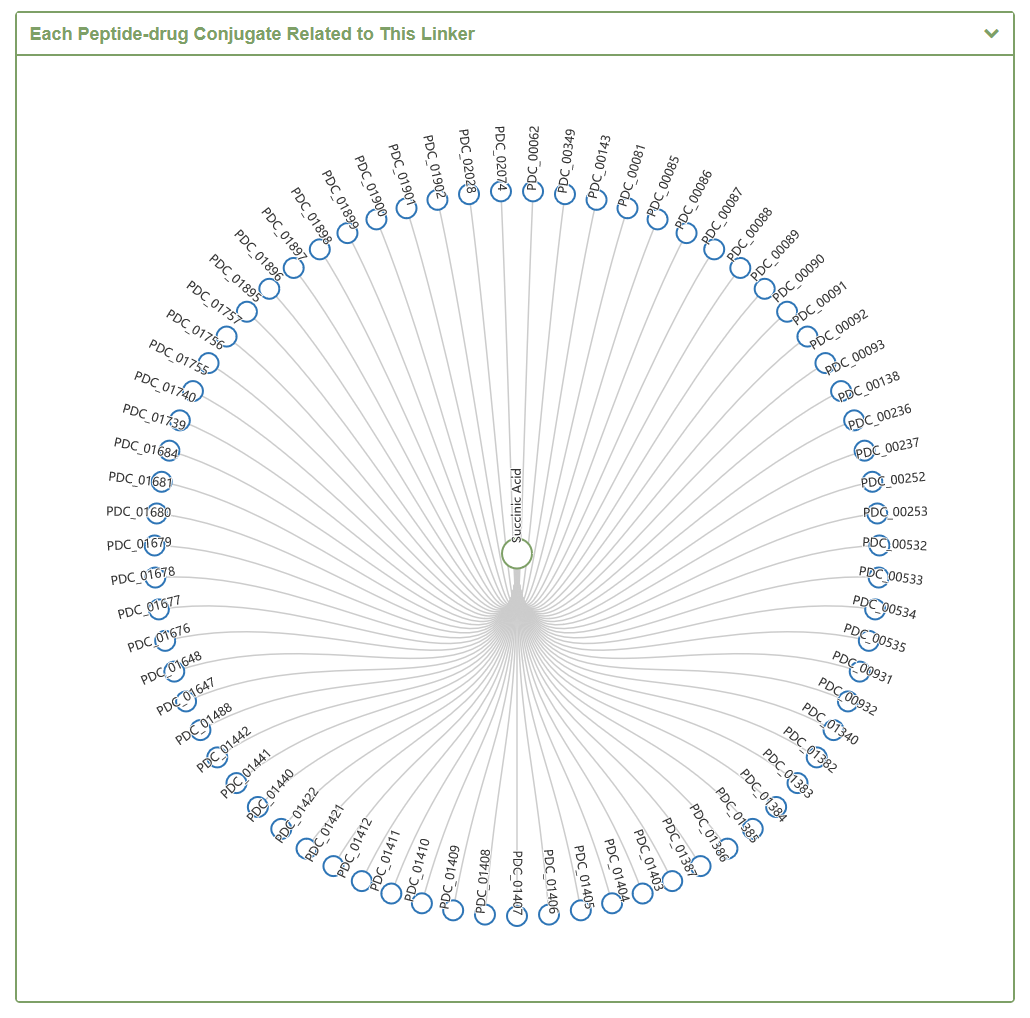
The "Full Information of The Activity Data of The PDC(s) Related to This Linker" section systematically reveals the PDCs conjugated with this linker. The list shows the different PDCs and the stage of research. User can get an overview of the different levels of activity data for each PDC, or easily jump to the corresponding PDC page by clicking on PDC Info.
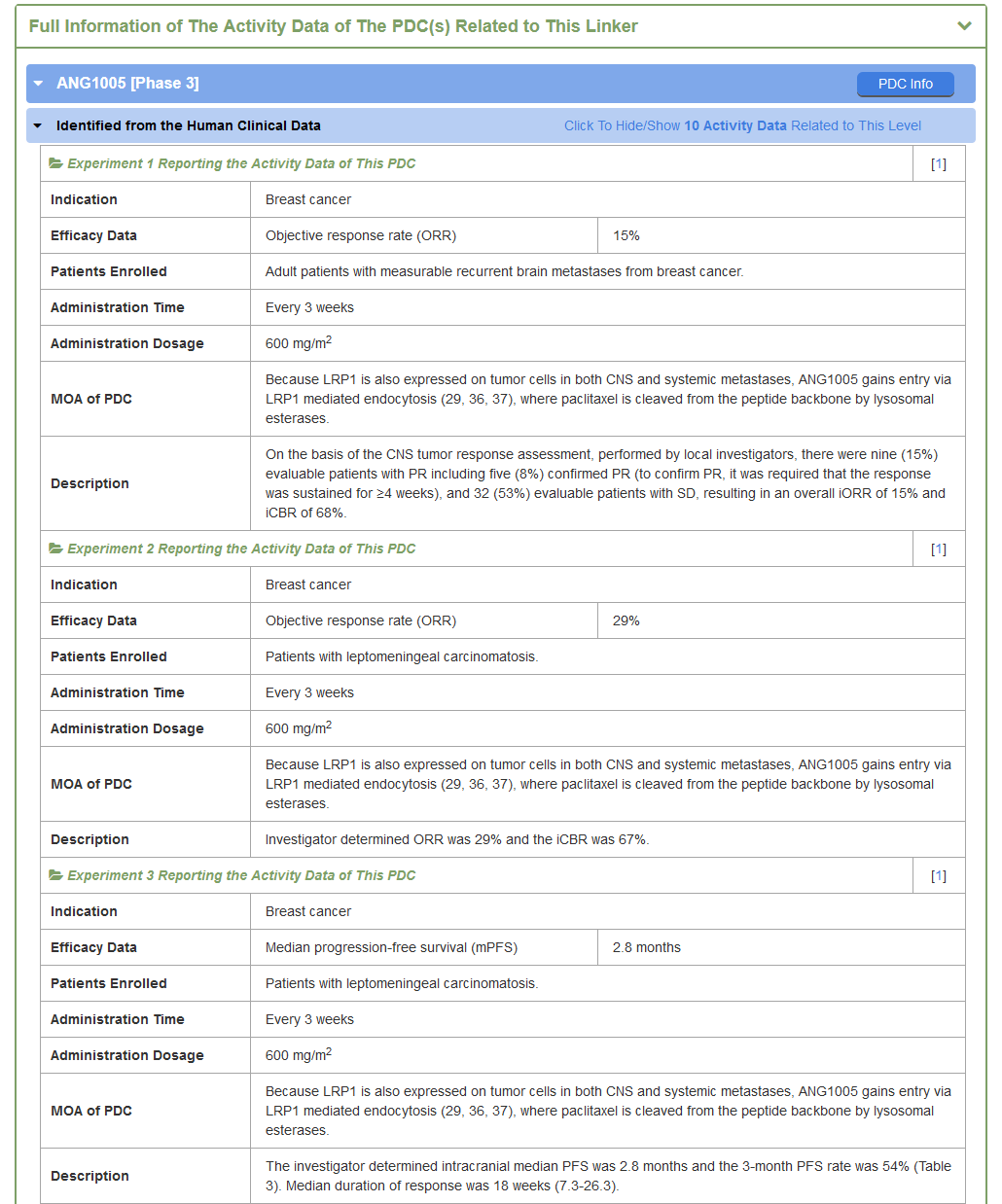
4.2. By clicking the “PDC Info” button, the detailed information page for particular PDCwill be displayed
Take TH1902 as an example, “General Information of This Peptide-Drug Conjugate (PDC)” section displays the general information of TH1902 including its ID, Name, Status, Indication, Peptide Modified Type, Modified Segment, Structure, Peptide Name, Structure, Receptor Name, Drug Name, Therapeutic Target, Linker Name, Drugbank ID, Pharm-Information and External Link(s). In addition, this section displays the general information of TH1902 including its PDC Name, Peptide Name, Receptor Name, Drug Name, Linker Name, and Indication(s).
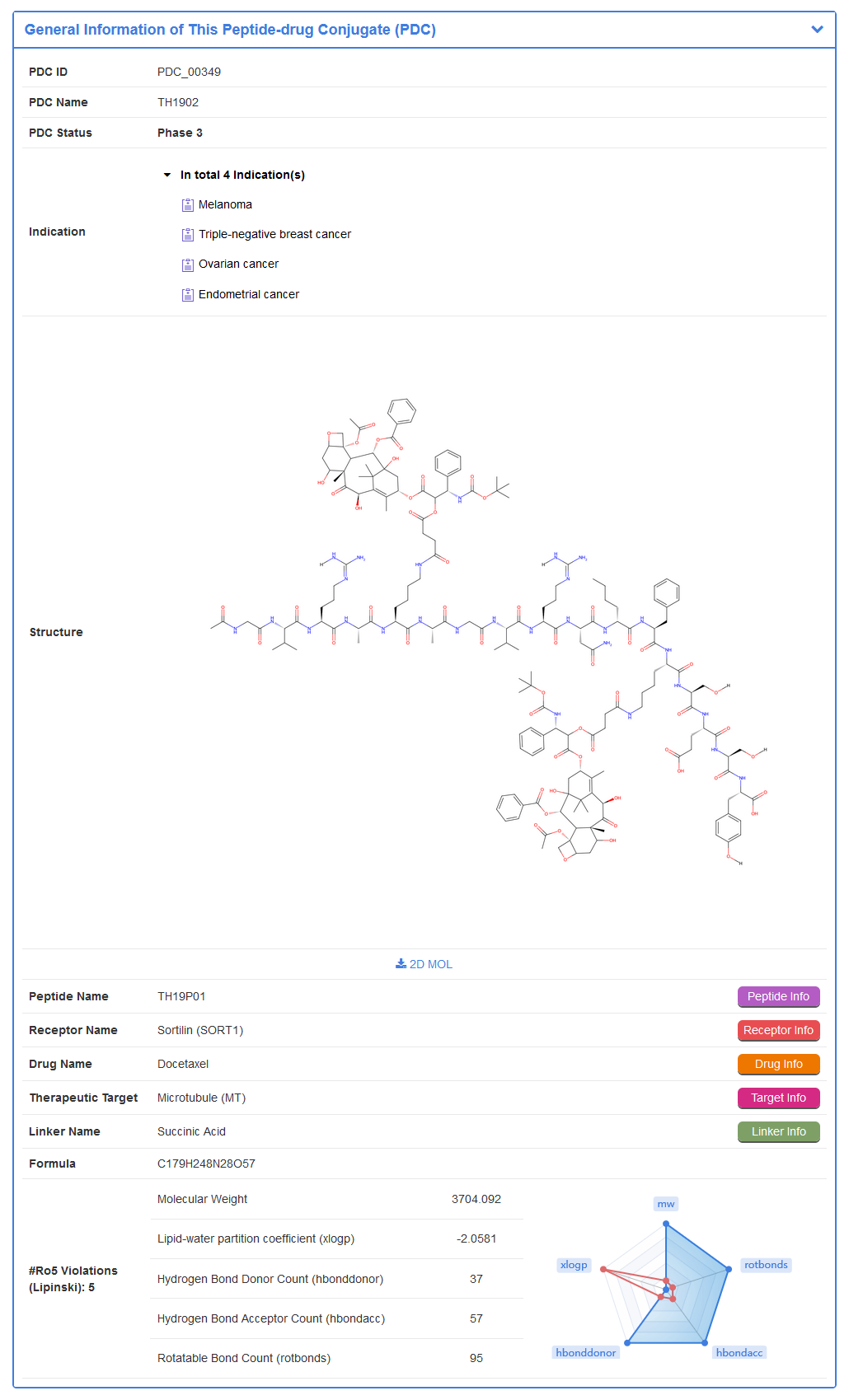
Some of the PDCs in the PDCdb have corresponding clinical study activity. The “Discovered Using Patient-derived Xenograft Model” section in the “Full List of The Activity Data of This Peptide-drug Conjugate” shows the Indication, Efficacy Data, Administration Time, Administration Dosage, Evaluation Method, Description, In Vitro Model and Half life period.
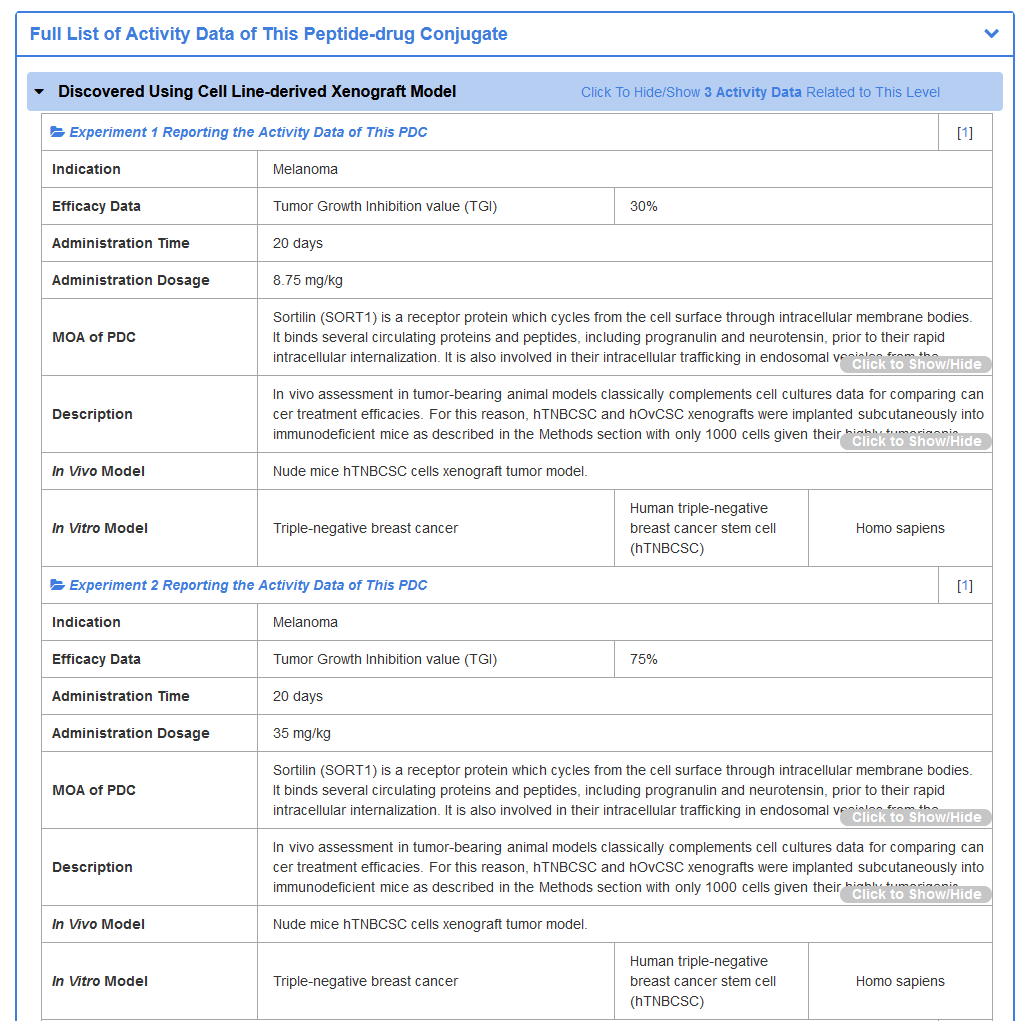
The “Revealed Based on the Cell Line Data” section in the “Full List of The Activity Data of This Peptide-drug Conjugate” shows the Indication, Efficacy Data, Administration Time, Administration Dosage, Evaluation Method, Description, In Vitro Model and Half life period.
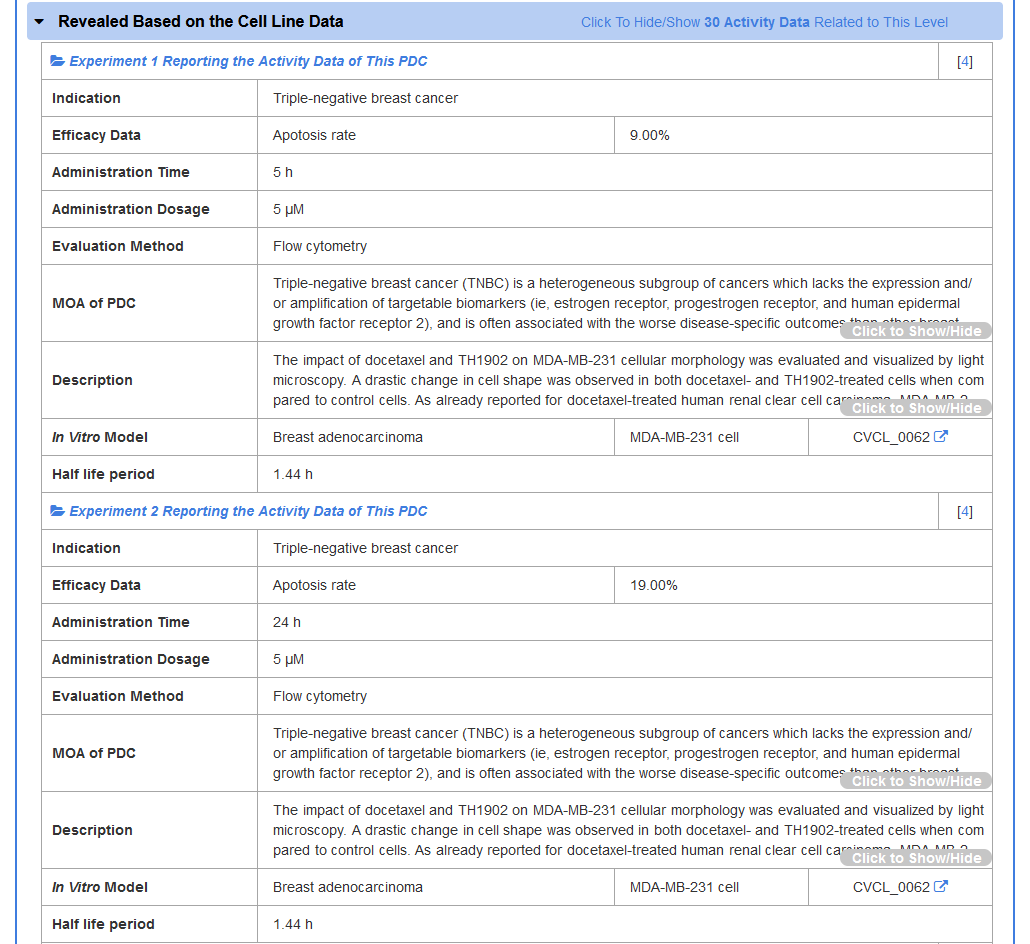
4.3. By clicking the Peptide Info” button, the detailed peptide information page will be displayed
Take TH19P01 as an example, “General Information of This Peptide” section displays the general information of peptide, including its Name, Sequence, Peptide Type, Receptor Name, PDC Transmembrane Types, Distributionand External Link(s).

"Each Peptide-drug Conjugate Related to This Peptide" section displays the PDCs associated with this peptide, with each button provided jumping to the corresponding PDC page.
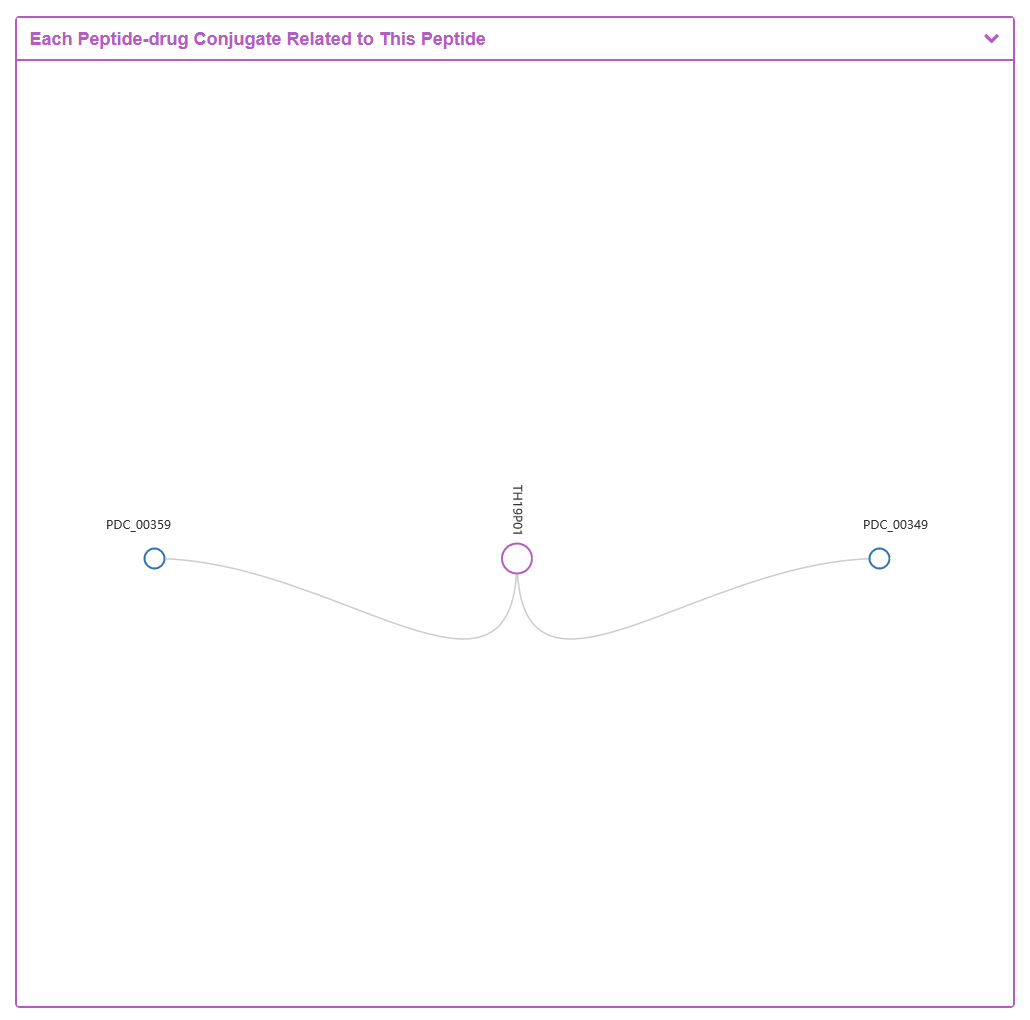
The "Full Information of The Activity Data of The PDC(s) Related to This Peptide" section systematically reveals the PDCs conjugated with this peptide. The list shows the different PDCs and the stage of research. User can get an overview of the different levels of activity data for each PDC, or easily jump to the corresponding PDC page by clicking on PDC Info.
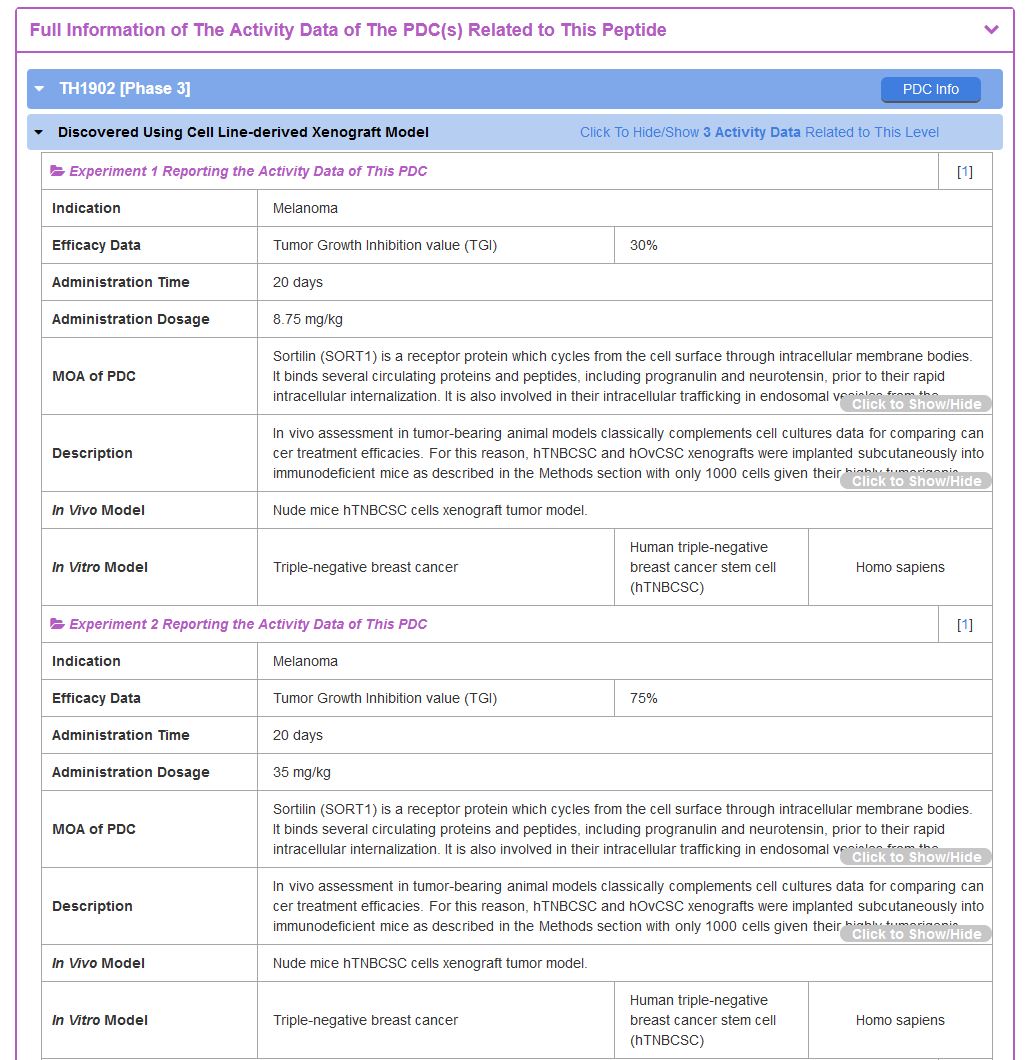
4.4. By clicking the Drug Info” button, the detailed drug information page for will be displayed
Take Docetaxel as an example, “General Information of This Drug” section displays the general information of drug, including its ID, Name, Synonyms, Target(s), Structure, Formula, Canonical smiles, PubChem CID, InChI, InChIKey, IUPAC Name, Pharmaceutical Properties and External Link(s). It is important to note that Pharmaceutical Properties is calculated by RDKit.
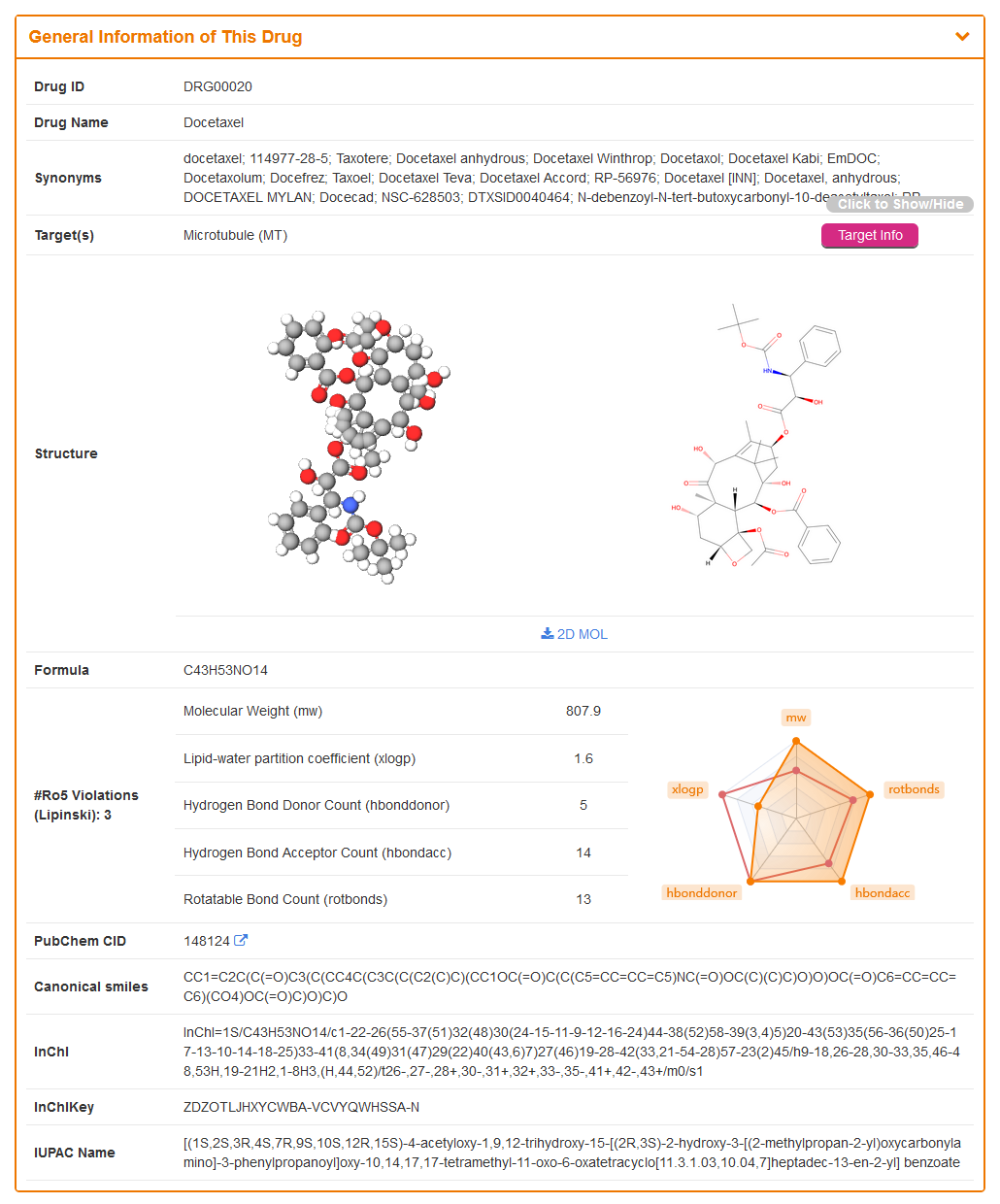
Some of the drugs in the PDCdb have corresponding single-use activities in vitro, and most are evaluated using IC50 index. The “The Activity Data of This Drug” section shows the Standard Type, Value, Units, Cell line and Cell line ID.
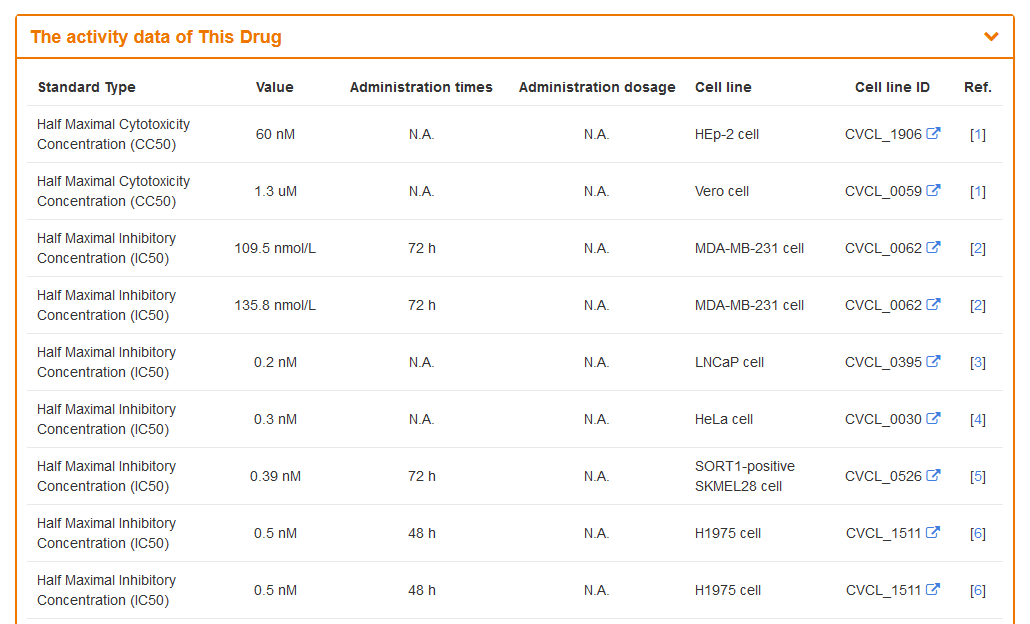
"Each Peptide-drug Conjugate Related to This Drug" section displays the PDCs associated with this drug, with each button provided jumping to the corresponding PDC page.
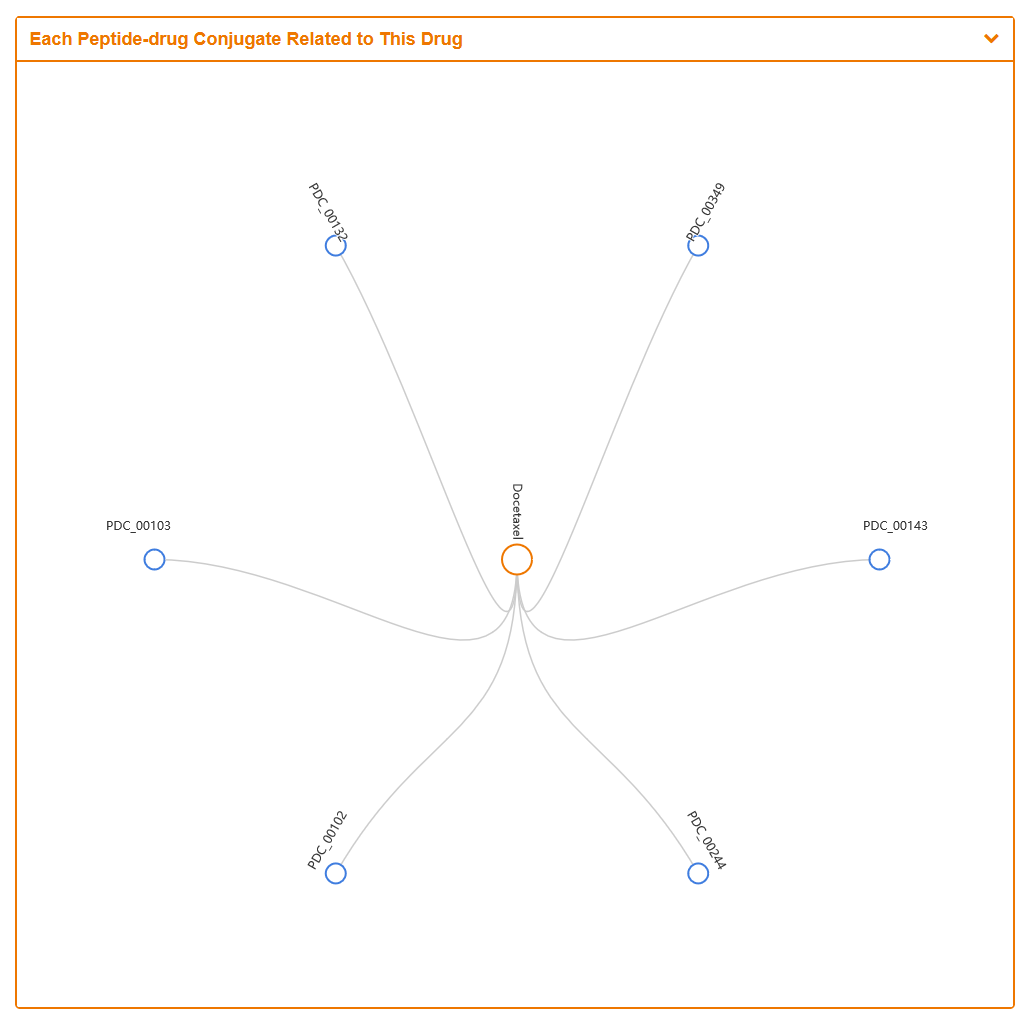
The "Full Information of The Activity Data of The PDC(s) Related to This Drug" section systematically reveals the PDCs conjugated with this drug. The list shows the different PDCs and the stage of research. User can get an overview of the different levels of activity data for each PDC, or easily jump to the corresponding PDC page by clicking on PDC Info.
